#northeast beach farm
Explore tagged Tumblr posts
Text
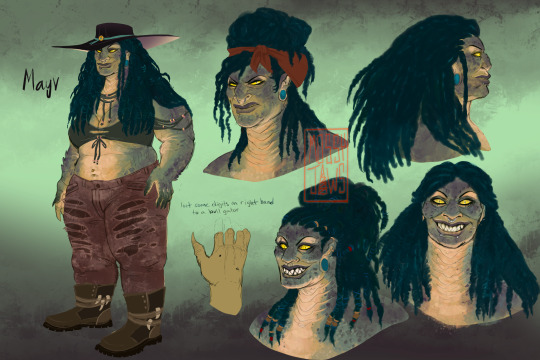
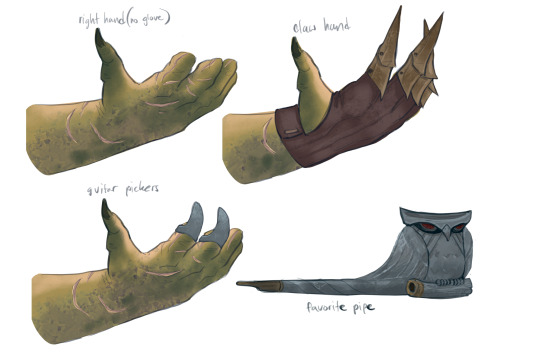
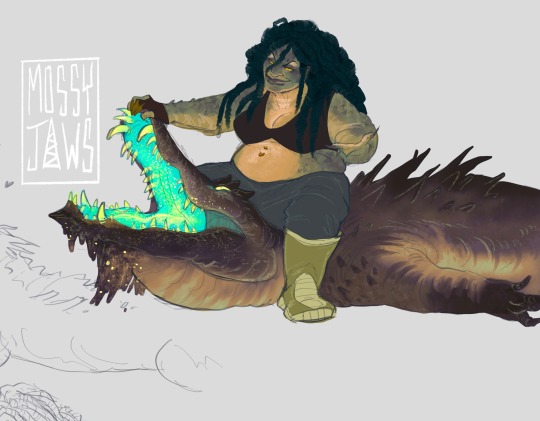
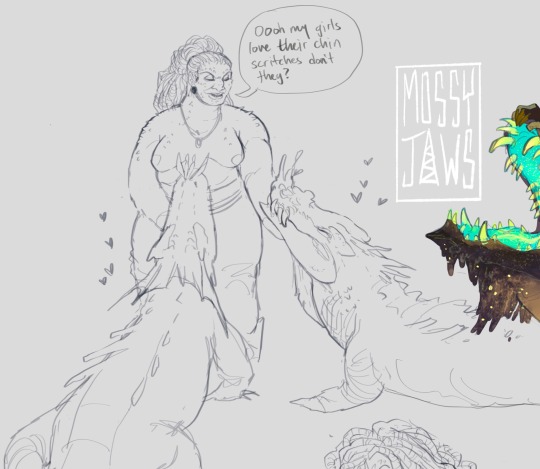
Here’s Mayv! Kraw’s adoptive mom. She’s wrestling a Glow Gullet Gator. She kind of owns a mutated gator farm on the side, purely for a love of the creatures (and they’re good as guard dogs)
Here’s a little intro for her ⬇️
She taught him all he knows about being a sea hunter and how to process and use mermaids for their organs and oils. She is a hunter first, an apothecary second and a ‘beast tamer’ third.
She found herself as an escapee when she was younger, commandeering a trawler boat with her two sons and a few other humans aboard. Whatever she was running from, she attempted to lose it by sailing straight across Hellmouth, unknown dangers be damned. A strange storm blew her off course however and in the process she lost both her sons and some of her crew.
The boat ended up beaching in the delta of a swamp that belonged to the “Lady of the Shades”, a mysterious harpy witch that gave Mayv her alligator-like appearance in exchange for safety. The swamp was called “Shades of Acheron”, located on the northeast edge of Hellmouth.
Mayv replaced her sons with Kraw and Titus. she found Kraw hiding within the swamp, his little hollowed out log lair surrounded by half eaten crawfish shells that earned him his name.
She ran their encampment and household with an iron fist but a loving and boisterous nature. It was mostly her training that Kraw deeply detested. More often than not, out on the sea she seemed to blur the lines between treating Kraw and Titus like her children and treating them like militant hunting hounds.
#hallowed carrion#mayv#for some reason tumblr won’t show me the words I’m writing?#like they’re blacked out…#so im writing in purple for now ifg#i only ever use dark mode so I hope its not hard on the eyes in other versions
424 notes
·
View notes
Text

The long weekend has come to an end for me. Traveled Northeast to Prince Edward Island, Canada. Visited the red sand beaches and red cliffs. PEI is big on farming. Also big on oyster farming which I was not aware of. Back to the rock bound coast of Maine come daylight for me to capture the Maine lobster.
8 notes
·
View notes
Text
State of California
I already implied multiple times how different yet imperative California is now in the BNHA-AU. How now there is a new ethnicity due thr mixture of Latin and Anglo (mostly Latin culture) culturr including a new language, how there is a new religion originate from here that now dominated Latin America, and just how different it is from today.
California is still have some similarity from today however; Sacramento is still the capital city with Los Angels still the most populous, it has the highest population (more than 80mil) and most powerful economy in the Union, and still important in the West Coast. Texas is still in second when it comes to population (around 50mil) and population, but ¯\_(ツ)_/¯. California also has the highest rail passengers by state alone, maybe similar to Japan ridership. It is likely it is only beaten by the Northeast corridor, but that region should have a population already at 100mil.
Geography
There is not much change when it comes to geography. It is not like there suddenly are topical rainforests (California actually has temperate rainforests). However, thanks to activists, technology, and laws, many damage to the environment by the Climate Crisis were alleviated. Many Redwood and Sequoia trees managed to reclaimed historic range and then some. There are bisons roaming California, too, with extinct animals brought by to life like mammoth and ground sloth, and mythical creature. California also change their agriculture practice, emulating how Dutch cultivated their products, using greenhouses, hydroponic for efficient water saving, etc. I not going get into more detail (go watch a YouTube about Dutch farming), but this method allowed majority of Central Valley be reclaimed by nature, making the land looks like what it did in the 19th century: Lake Tulare is now permanent, marshlands and has a huge delta.
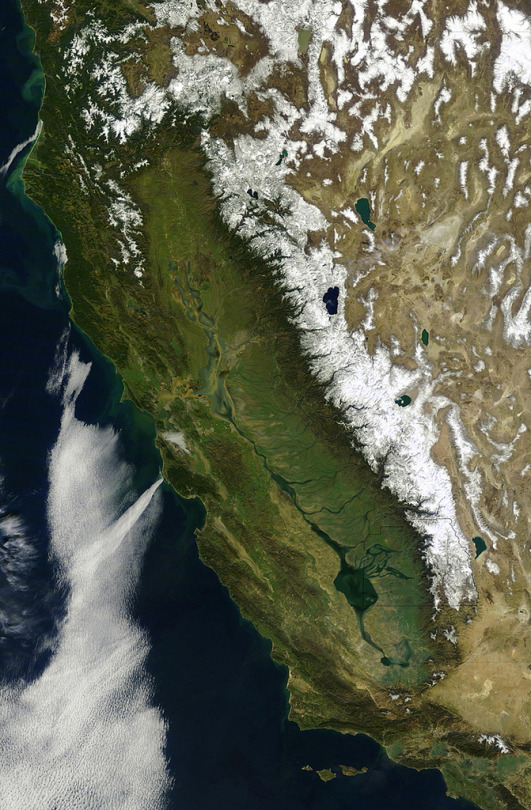
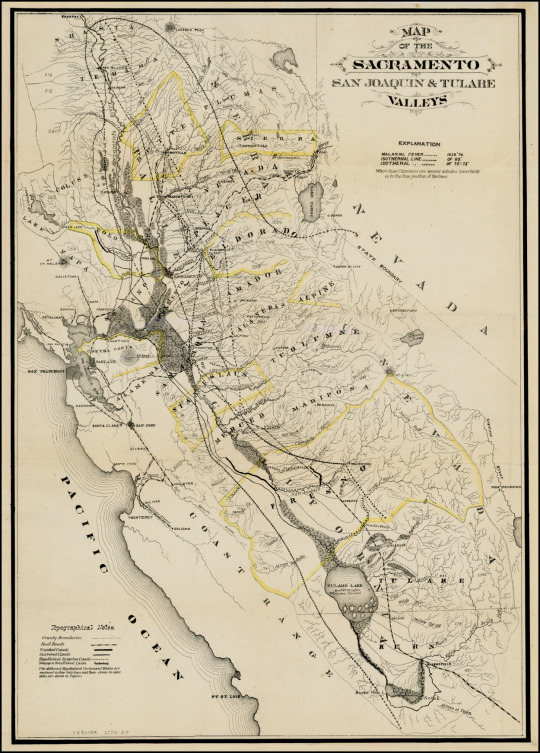
California also deurbanization (actually desuburbanization) many sprawling cities across the state. For instance, the cities I used to live in -Brentwood and Discovery Bay - are now gone, paved out. Many cities, especially in CV, have greenbelt, which also act the limited of their jurisdiction. I also think, with the Climate Crises alleviated, sea levels will drop by a meter or so, so now half of San Francisco Bay, especially south of San Mateo Bridge, is gone, mostly just salt marshes (and no, there are laws forbidding development on it).
There is a bit more rain due to El Nino and La Nina weather system now having a precedence. Like 2-3 years Nino and then 2-3 years Nina. So there could be a drought season. However, those also mean there's a lot more run, even during the mid-spring to mid-fall in Nino. Tropical storms are not uncommon during Nino, at least 1-2. This also means California will lose like a quarter of their desert are gone, so Antelope Valley and San Bernardino Valley biome are similar to Central Valley.
Cities
Bit difficult to talk about cities since some cities changed their name, some new ones, and that I need to make a map. I gonna try to convey the city position by only referring high population, North to South.
Redien- (Redding)- 500k. Know for rail connecting to Redwood Empire Corridor and to Oregon, high percentage of non-Kalifornáns, and high population of Therians/Lycan (Enid lives here).
Bí-Sierra (changing the name)(Chico) - 400k. Know for: ¯\_(ツ)_/¯
Yebu -250k. Know for: ¯\_(ツ)_/¯
Sacramento - 5mil. Know for being the capital, HQ of Golden State Railway Company.
Metropolis of San Francisco - 17mil. Know for the birth of Califity, Memorial of Califia, Angel of the Bay Statue (looks like a Japanese woman wearing a kimono, also know as Liberty of the West)/Museum of Asian and Latin Fredoians between early 19th century-1950s and Beyond.
Amid-Tu-Rifã (changing the name)(Stockton)- 500k. Know for looking like Venice and Amsterdam.
Tuolumne-ín-Estanislao (Modesto) - 500k. Know for: ¯\_(ツ)_/¯
Santa Cruz - 120k. Know for beaches and UCSC.
Salinas -1.2mil. Know for just having an HSR train.
Monterey -90k. Know for the aquarium.
Lafenia [Lafenã means Lavander in Californin (Madera)] - 3.5mil. Know for having the HQ of Rolosron (Golden Iron) Company (focus on rolling stocks), SU Laféna (focus on urban design, transportation engineering, and architecture), and vocation on public transit course.
Fresno - 3.2mil. Know for not being Fresno anymore and a dry port (ironically, it's adjacent by a massive river).
Nés Nakiśa (City near Visalia, between Tulare and Tipton)- 2.5mil. Know for being named after Nakiśa the Lover, the Innocent, and the Miracle-Worker.
Nés Ana��s (Bakersfield)- 3.7mil. Know for being the birthplace of Anaís, the Lover, the Guardian, and the Martyr.
Santa de Nagasaki, also called Sanagi (in Santa Maria Valley) -6mil. Know for being a cyberpunk-like city (dont know if that's a good thing or not), cyberware and powered suits industry, and the few pro-hero academy in the world meant for non-quirks. It was a former city-state between the Dark Age to 2200s.
Santa Barbara- 200k. Know for just being a nice city.
Metropolis of Los Angels - 24mil. Know for the Gate of Angels (mixture of Brandenburg Gate and Arc de Triomphe, at San Fernando City), Los Angeles Central Station (mixture of Penn Station and Grand Central Station), Los Angeles Grand Park/The Meadow (bigger than Central Park and Golden Gate Park, at the former city of Compton, adjacent to LA River), The Sequoia (think Tokyo Skytree, have branch-like Observation deck, 670 meters tall, somewhere between Mid-Wilshire and Koreatown).
Rifãsíd (Riverside)- 500k. Know for ¯\_(ツ)_/¯.
San Diego- 9mil. Likely just the same as today.
All together, this brings it up to 78 mil people. There are other cities, towns, and villages in California like Eureka, towns around Lake Tahoe, and others around, but theses cities are considered either major, well-know, or important. All these cities, with the exception of Santa Cruz and Monterey, are connected by NAHSR, and Sacramento and Los Angeles are connected to the Continental wide Maglev network. I gonna explain California railways network later.
Most of the cities kept today boundary, however demolishing many of its sprawling suburban housing. Like I said before, most cities city boundary are tangible by its greenbelt, and they can't, by state-law, develop pass it unless their km density passed 25km, which many city, especially in Central Valley, haven't pass it. Actually, many cities in the Valley have an average of 250km land areas, with average of 12k km2 density.
Many cities, but especially to SF and LA, have patches of urban forest. Not parks meant for recreation, but forest that is meant for nature. SF and LA have many patches of those urban forests, many usually 1 km² but could be higher than 100 km². They used wildlife crossing to connect them all.
Many cities looks like a mixture of futuristic architecture (I will talk about that later) and somewhat traditional-like like Isabelan architecture (eclecticism of Spanish Colonial and SF-like Victorian architecture, need to talk about that). However, Sanagi is just straight-up cyberpunk city, like I will call it Capital City of Cybernetic, with having an unusually higher percentage of Non-Quirks. Non-Quirks are more likely to installed cyberware than Quirks, to the point majority of their bodies is cybernetic. (Lets not kid ourselves, with BNHA having robots the size of skyscrapers and artificial islands in the middle of the ocean, yeah they will stereotypical cyberpunk technology.)
Economy
I think I hinted this before, but California, and frankly majority of the world are what I considered social democracy, or at least, some form of socialist. In California (and Fredoia), almost every necessity goods or service like water, energy, internet, healthcare, public transportation (including airlines), etc. is own by the government. Meanwhile, some that considered necessity but needs some in-hand by the people like housing (majority of it), foods, etc collectively owned either by neighborhoods (districts), groups, or guilds. Now I think about it, it kinda similar to Post-War Britain, especially how it comes to Attlee policies.
In California, the state has a market socialism and guild socialism (Democratic Socialism). There are companies that are controlled by employees; democratically elected company leaders, a 1 to 5 ratio wages, input how the company should be headed, etc. Half the company stock is owned by the employees, and the other half is owned by the local governments, which is then controlled by the people. They voted how the stock revenue should be allotted and apportioned accordingly (either funding for transit, schooling, maintained, etc.). However, sometimes, thanks to public banks, they will give denizens the money through all the stocks in the city.
For guild, sometime a mixture of labor unions, company of laborers, or craftmanship. Many cities have guild in it jurisdiction. For instance, and this I have an idea for a while: biking is considered a one major ways of transportation in California. Because of that, bikes is a huge industry in the state, bikes repairers and retailers are common in cities. A guild that focus on biking will required those to join to and gain a permit. The permit is meant for laborer protects, universal bike parts, . Meanwhile, customer who have a warrant for the city bike guild could go to any bike repair: if they broke their bike kilometers away from their usual repairers, they could go to a close by repair shop and have it fix free thanks to the guild warrant.
Another city guild/company is like a group of crafter who also works together, but unlike something like a bike-like guild, it act more like a company whose own/control/manage by the city, like for construction company. It will be more efficient since the city will have experience with laborers, more efficient in talks and shit, and if there is unneeded constructions, many laborers will simply be put on paid leave (which kind of unnecessary because California is always either building or maintaining something lol).
Agriculture is owned by small farming communities. Honesty, they likely lived in Tipi-like housing similarly what I talk about in my last post. Their farming is just straight up just like the Dutch, which give higher yields for hecto without needing to use more lands. The government will give the community findings and buy their products so to keep foods extremely low. the government will then sell it, low price, to merchant/retailers who then sell it to consumer in again, low price. However, 1/3 of foods product in California is grown by urban farming.
The majority of housing is collectively controlled by locals/tenets. I based it on Singapore town council and House and Development Board. I know that anyone who knows about this is probably not a good thing, but the other synonymy or trying, think of example is Homeowner Association, which is worse. Each city (or ' special wards' for metropolis cases) have districts, which democratically handled housing (and other buildings). They also have delegates for the city council. The district receives tenets rents and is handling it by either paying utilities, repairs, or insurance (not like insurance company, "just-in-case" like natural disasters, hero/villain's battle, etc.). Prices are dependable on housing types (a duplex will be more expensive than an apartment, while a town house be more expensive than a triplex), rooms (if you have kids, the price will be lower), floors, material of the building itself, and construction method. But price are all fixated, meaning if there a housing that have all the characteristic in two different location, and one is consider far more desirable for its surroundings, the two housing are still the same price. In today markets, we usually handle this by outbidding another buyer, which increases house prices. This is the reason why San Francisco is so expensive. Instead, California housing is handled by a lottery system, fairness by fate instead of higher monetary. Some participant are allowed to have some advantage depending on their situation: if they live in the district/city majority of their life, if they have a family, they lost another lottery, they are about to be homeless soon, and such. Ironically, Frinsica (San Francisco) is still difficult to get a house there, lol.
In housing there, people either rent or buy housing. By renting, it usually cheaper- if we using today renting price, an average price for like an one room apartment will likely be $150 per month (people have limits of free utilities until hiting that limit. Parking isn't included and is optionable since like more than half of California doesn't have a car). It's for people living short-termin the area, occasionally students for either high school/college who doesn't want to live in dorms/SRO, newly adults, or people who simply want an easily life (which is not stigmatize in California). However, it usually has a maximum limit of how long someone could rent there (usually 5 years), so people are either evicted or pay an expensive extension. Buying a hosing is also preferable and also cheaper than today. I don't know what is considerably an average price, but likely a triplex unit will cost $150k (you not owning the entire building, just the unit. You do collectively share it with two other owners). Buying is likely similar to how Singapore housing (go look at a YouTube video, lol). One thing to note is that the owner cannot sell their unit or rent it to another tenet. They could only sell it to the district, which would likely be the same price with 5% add. The owner could allow their unit to be inherited or allow friends/families/associates to live in it, but that likely it. Selling or renting it will defeat the purpose of a lottery system.
There is a national bank, a public bank owned by the federal government. Each state have their own banks which connected to the federal bank. The benefits is there is no monthly fees, withdrawing money from other state bank atm without fees, easier gaining loans with lower interest rate (great for starting business ), better retirement account which also connects to social security. However, there is a limit how much someone could have in their account before they start paying a monthly fee: $100K, and the fees gets much higher along with the saving account. (Also, it is common for people to have two retirement, the average lifespan is 160 years, and there are also quirks that allow some people to have longer lifespans).
For artisan guilds like for writers and artists, there is likely an universal-like wage so writers/artists could allow to do their craft. However, there is likely a quota/requirement so they actually do what they meant to do.
For exports and well-known sectors, it likely will be the same as today with some key differences. For one, they know for rolling stocks, specifically for HSR, metro rails, and trollies. The company that handles it, Rolosron, is located in Laféna. Another is Kalimé, or sometimes called Kaliniśon, animations production in California. It has their own unique style, similar to anime in Japan: inspiration, and how I think it will look like are SPOP, Gurihiru works, and some comics like Specter Inspector. Produced in either Los Angeles or San Francisco. Cyberware is also well-known, many of which are produced in Sanagi. Maybe also biking manufacturers, revenues from Califinitan pilgrims, and likely that it.
Half the main energy source are renewable, including solar energy, wind energy, ocean tide, and hydroelectricity. The rest is nuclear fusion plants, and when I mean plants, I mean there are only four plants in the entire state (they needed imported huge amount of tritium gas, also yes, there are still fission plants). There are also room-temperature superconductors, which it is not as common so its usually use for either fusion reactors, transmission tower (almost all California's wind power comes from the Great Plains), energy storages for cities. They are also getting into the noireau (metallic hydrogen) industry.
California working hours is 6 hours, and could only work for 4 days. Cause of this, they have 3 day weekend. In Califinity, they viewed that person must time in three order: Friday for resting, Saturday for indulgence, Sunday for praying. They also get 2 four weeks vacation and 1 three weeks of vacation.
Transportation
YEAH! This is the one I waiting for; I keep indulging about California having an intricate rail network. For now, I gonna talk about non-rail transit because I dont fuck around with trains.
The majority of California used rails for transportation, with Los Angeles rails having 28mil passengers in a city of 24mil (wondering how, go look at Tokyo transportations section in Wiki). However, there are many people who also use either the bus or are preferable to either walk or bike to their destination. There are people who uses cars, but it a privilege to use it, and expensive too: there is congestion charge, parking fees, registration fees for battery cars, high taxes for either ammonia or noireau fuels , and high tolls for using Interstate/Expressways (maybe like $1000-1500 for per year, and higher for freight trucks) (many freeway/interstate were demolished in inner-cities however).
Not only that, many cities have streets design that are similar to Tokyo and European cities: having few boulevard that connect the city in boarder scale, but have streets that either one-way, or pedestrian only zone.
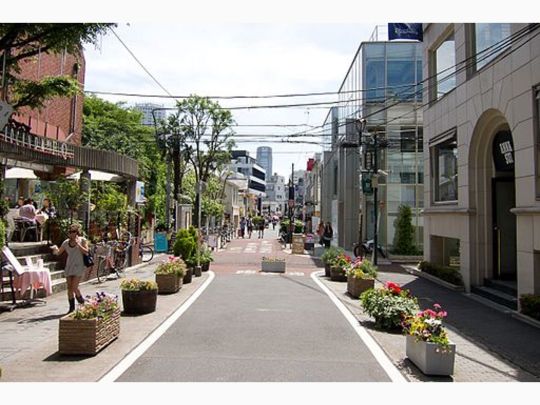
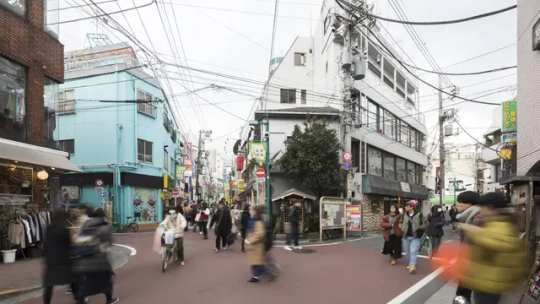
This kind of street are very common in California cities.
California owns a state-enterprise airliner, Golden Airline. There are only 5 major airports in California, 3 that deal with international (as in, non-UNEC member)/intercontinental destinations): San Francisco International Airport, Los Angeles International Airport, San Diego International Airport, East Bay Transcontinental Airport (Oakland Airport), and Santa Ana Transcontinental Airport (John Wayne).Not only are there fewer airports, but intrastate flights are banned in the state. Thanks to federal law, constitution, and UNEC, flights are also banned to Oregon, Nevada, Arizona, Navajo-Hopi, and the State of Baja California.
Rail
California owns a state-enterprise that deals with rail passengers called Golden Railways Company (HQ in Sacramento). Actually, it is one of seven subsidies of Amtrak, which is far larger than today, to the point there has to be smaller companies to deal with railways. The other is Lone Star Railways (Texas and California are the only states to have their own railway companies; HQ in Austin), Northeast Railway Company (Northeast region including Maryland and DC, HQ in New York City), Russet Railway Company (Midwest States that isn't under Lakotah lands; HQ in Chicago), Cascadia Railway Company (Oregon and Washington states; HQ in Olympia, WA), South Railways Company (can't think of a good name lol, compassed all other Southern States; HQ in Atlanta, GA), and Sunwest Railway Company (Southwestern States including Idaho, Montana and Wyoming (any left over lol); HQ is maybe either in Phoenix, Santa Fe or Denver).
California has a massive railway network; it's possible to go to any destination via rails in the state, via regional corridor like the Redwood Empire Corridor (talk about that soon), or intercity/hsr. California two important corridors; the Golden Corridor that goes through Central Valley all the to San Diego (and connects to other states and countries), and the Southern Range Corridor (also called Salinas) that started in San Francisco, goes through Salinas Valley, to Sanagi, Santa Barbara and then Los Angels.
The Golden Corridor used the legacy route of CAHSR, a project that, despite its flaws, was fundamentally crucial for the state. I gonna digress for a bit but people bitching about how the route "should be shorten" or go pass certain cities missed the point. California does not have a good connection with its cities. Yeah, there is Amtrak, but the issue is that it is too slow for conveniences, many of its tracks are owned by freight companies, and there are no direct routes for SF-Fresno-LA. The reason why there is such high population in Central Valley is thanks to CAHSR (and other things). The only reason there is some route change is because there are always things to improve on, some cities are just gone, and there are other routes that don't need HSR.

(What the majority of GC looks like)
There is some new routes and changes of route. For one, it goes further norths to Chico, Redding, and then to Oregon. Another is the corridor at SF-Jose. Right now, CAHSR will share with Caltrain, using the same rails. It is great because it electrified the rails. However, there are some flaws. There are still level crossing, which, admittingly, some are being constructed to have grade separation. Another issue is that it has double-track railways, and it's in the middle of an urban environment.
A few decades after Califia's death (maybe 2080s to 2090s), California has somewhat of a rail revolution, transforming the state railways. For one, the state converted half of state route 101 (SF-Mountain View) into quadruple-track railway. The benefits that it allows HSR trains to go faster, allowing other trains to share (the Bay Area has a RER/S-Bahn trains), and is more separate from urban neighborhoods. The corridor split off from MV: one goes to San Jose Central Station (dual-track again), another still going along US101 than merging with IS880 (still a quad-track). The former Caltrain corridor is converted into a BART line (which is owned by BATA- Bay Area Transportation Authority/likely succeeded Seamless Bay Area). Once the corridor enters SF, it follows the same route of US101 (there is now freeways in SF), which, instead following CAHSR terminating underground, it goes to SF Central Station at the former IS80 above ground. It's a through-station and follows into SF-O Bay Bridge, which either goes to Oakland 16th Street Station, or continues to Sacramento. The Bay Bridge (Golden Gate Bridge and San Mateo Bridge too) itself is similar to New York Manhattan Bridge and Brooklyn Bridge: railways in the bottom, 3x3 road, and a pedestrian/cycling route atop.

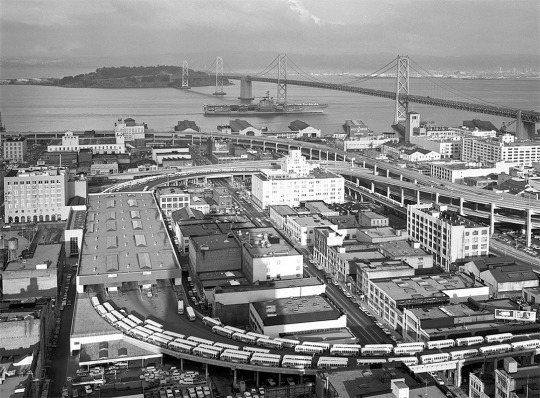
(Where SF/Frinsica Central Station will be located. Also note this is the only way for cars to enter the bridge. Also, i am hitting on my image limit, lol.
For the majority of the corridor, from Sacramento to San Diego, the majority is quadruple-tracks. Well, maybe six-track if you count Maglev, it fellows the Golden Corridor. Also, San Francisco is the largest city in Fredoia that doesn't have a maglev station (lol, lmao even). Some cities are gone, so the corridor does not stop there. Kings/Tulare is Nés Nakiśa, the one near Visalia, and then to Nés Anaís. If a city is adjacent along the corridor, it will have a station, but the HSR will bypass it. There are also minor corridors that connect to the Golden Corridor. Best metaphor, the Golden Corridor is an artery that connects capillary.
After Bakersfield, it bypassed Palmdale and continued to Burbank/LA. Like I said before, Palmdale is connected to the Golden Corridor and does have it own Corridor, its only that HSR does not go there. After LA, it continue down south; it does not go west to San Bernardino. Instead, it continues journeying to Anaheim and then cutting through Chino Hills towards Riverside. From there, it either goes to Las Vegas and/or Phoenix and/or Jeddito and the rest of the country. Or it continues to San Diego, Tijuana, Mexicali, and then all the way to Mexico City. It is quite common for Californians and Mexicans to travel for either places thanks to UNEC having a open border policy.

(Notices how once stopping at Riverside, it either goes south, north, or northeast). (Also, I mention before and forgot to said it here, HSR can go up to 450 kph (average likely 400 kph). How they achieved this, other then making sure the corridor is as straight as possible is by: having wireless power transfer beneath the tracks (not eroding the overhead lines), concretene (concrete that has graphene mixed in it) to withstand the vibration and have longer lifespan, and nistíl (neo-steel which is my own idea; just steel itron mixed with graphene) which also withstand the vibration, friction, and have a longer lifespan).
The Southern Range Corridor, or the Salinas Corridor, is another corridor that meant for HSR. The Golden Corridor became extremely congestion: not only regional and HSR trains are using it, but also interstate and international trains frequent the route. So GRC constructed another corridor (likely in the early 2200s) to alleviate the main corridor traffic. It also has many cities in this region, especially Salinas and Sanagi, that don't have proper train lines. The corridor started from Gilroy. Instead ofgoing east, it goes south, going to Salinas. Then it goes southeast through Salinas Valley, continuing all the to Paso Robles. Then it goes south through the mountains, going through San Luis Obispo, then stopping at Sanagi (Santa Maria Valley). It then goes southeast again to through another hills, stopping at Santa Barbara, then through the mountains again to Ventura, goes to Oxnard, Camarillo, and then to Los Angeles Central Station.
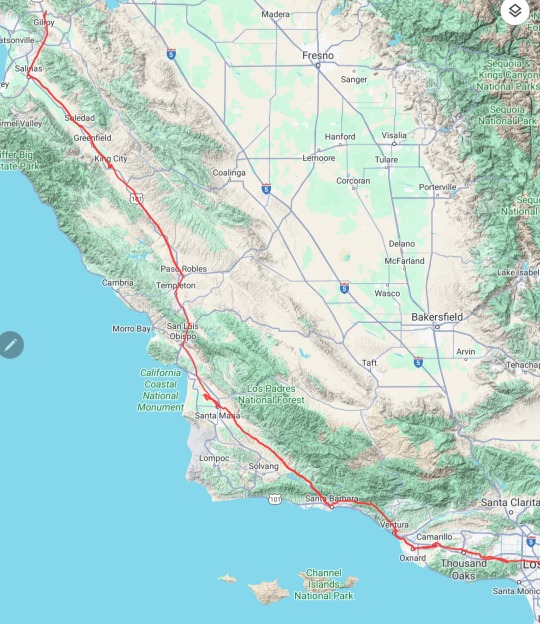
(What the corridor looks like)
Now, the Golden Corridor and Salinas Corridor aren't the only corridors, but those two are the most important, having HSR lines and high traffic. There are other corridors in California, local/regional ones that connect to either corridors. Small traffic yet crucial. One corridor I want to talk about is the Redwood Empire Corridor.
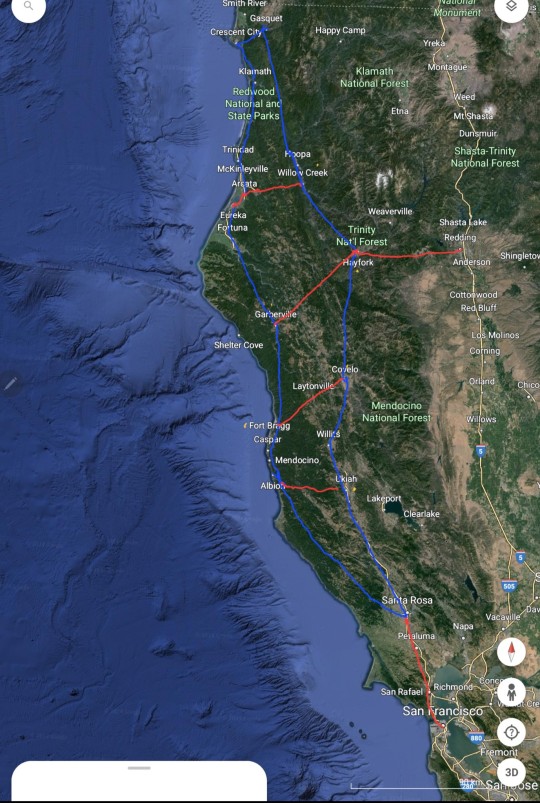
(red is dual-tracks and blue is single-tracks)
The Redwood Empire population, minus anything south of Santa Rosa, is around 750k. Once past Santa Rosa, the corridor goes in a counter-clockwise. The red that goes east-west allows the line to form a 0-shape route. There is like an average 15-20 on the line. I got the idea from Not Just Bikes video about Switzerland. Thanks to this, there are far more people who travel to Redwood forest, especially in spring and summer. There are other corridors in low-populated regions that use similar routes.
The state entire uses clock-fast scheduling- arriving or departing either at 0s or 5s- and pulse timetabling.
There are different categories and types of rail trains, basing it off from Germany and some from the UK. The reason why those two is because it's the only one I can find in Wikipedia, lol. Usually based on how important the hub is, intermittent trips, number of passengers daily, and huge the building is. If I properly made a category list, LA and Sacramento will be 1 (having a maglev stop) while San Francisco and Lafénia will be 2 (not having one. Also, being the last stop before an important junctions is the reason why Lafénia has such a high population).
Education
Before I startn I need to remind everyone that the average lifespan is 160. This means that people ages slower, including sexual maturity like some animals like giant tortoises and bowhead whales. So there people in their 50s who looks in their 20s, or in their 90/100s who looks like in their 40s, similar like Aragorn from lotr (this also means women/afab are averagely 2-3 inches shorter than men/amab, and menstrual cycle is 60 days. Average Ostrace age is usually 200-250 excluding Kitsune and Sanguinarians). So schooling lasts a bit longer than today. (Also, California schooling is implemented country-wide with some difference.) There are laws that require schools to be surrounded by pedestrian-only streets. School days are Monday-Thursday. Some schools also have Friday but it is only half-time
There is 4 levels based on age:
Elementary school, also have daycare :0-8
Primary School: 8-12
Lower Secondary School: 12-16
Upper Secondary School (referred to as Liséa in Kalifornán): 16-20
Elementary schools are far more common than the other 3 schoolings, with an average 1 elementary per 1.5 km. The reason is that is so young children could be closer to their schools. It compassed pre-school, kindergarten, and Grades 1 and 2. Elementary teaches students their primary language (Kalifornan), basic math, and such. An average elementary will likely have a body of 100-200 students, with teachers having a class of 8-10. The elementary playground will also act as a local park. Elementary students are also called Ducklings due teachers picking up their students and herding them to schools like a parent duck and students wearing bright coats.
Primary schools are a bit more widespread due to students being supposed to act more independently, maybe like 1 per 5-10 km. Students are supposed to learn their second languages (usually either English or Spanish, but in some cases, a different language if the neighborhood has a large non-Californian population). An average class has 10-12 students with 500 per school, and students stay in the same class all day. Parents pick their child schools. Schools last 8:30-1:30
Lower Secondary School is widespread too, with 1 LS per 10-20 km. Students again will learn another language, learn more complex subjects, and such. Average classrooms are 12-16 and like PS, students shared same classes. Students are allow to pick their schooling when entering Lower School. School last 8:30-2:30.
Upper Secondary School (or Liséa in California) is far more widespread, with 1 per 20-40 km. Unlike the last three, students do not share classes but go to classes individually. UP acts more like a university than the other schools. Students may learn another language, but it is not mandatory. Not only students may choose their schooling but they could go to another city's schools if desire. It is common for students from small cities and towns to go to bigger cities like SF and LA for schooling (staying at either schools' dorm, social single-room occupancy, or renting an apartment). Students also gain a counselor who guides them for post-US life and careers, especially if it's related to their quirks. It is dependable on the student's schedule, but Schools last 8:30-3:30.
From Primary to Upper School, all students are required to wear an uniform. However, dress code is only not strict but students are courage to customize their uniform, embracing California social individualism. Gender restricted is illegal, and students, regardless of gender, are allowed to wear either pants or skirts. In fact, it is common for boys and masculine genderqueers to wear skirts during summer classes.
Classes scheduling is dependable on cities and their school district, but there are causes where classes have hybrid scheduling of Block and Timetable, with all 8 classes the first Monday, and A/B for the rest of the week. However, some classes, like language and math, are required to be held daily. A school year lasted from late March-Late June = 4/5 weeks vacation= Early August-Late Nov./Early Dec. = 4/5 weeks vacation = Early Jan - Mid/Late Feb = 2/3 weeks vacation = New School Year.
There is a new legal status called Minor. When a student/child reached the age of 15 years-old, their legal status will be listed as Minor, a transition from childhood to adulthood. Under this status, they enjoy far more privilege than they did as a child:
Allow to consume alcohol that is under 5%.
vote in local election.
Go to doctors without parents permission and do minor procedures like HRT
Watch +16 movies at the theaters.
At age 20, they allowed to do:
Voted in State and National-wide election and run for local office.
Consume all levels of alcohol.
Watch +20 movies at theaters.
Allow to do major medical procedures like gender-assignment surgery.
At age 25, they allowed to do:
Run for state and national-wide lower-chamber office (upper chamber and executive branch is 35).
Join the military.
Allow to work in Pleasure Guild (adult films, sex workers).
Drive and operate machineries like cars, trucks, trains, planes, etc.
Culture
The majority of Californians are an ethnicity I already talked about, Kalifornán. Kalifornáns formed (how does a new ethnicity happen?) due to many other Latins ethnicities' culture, especially Mexicans, shared, borrowed, and merged their culture together with Anglo in California. The language, again called Kalifornán, formed from Spanglish. Kalifornáns is primarily found in California, but many are also found in either US states like Arizona and in Mexico states like Baja California.
Kalifornáns are usually energetic and cheerful, more so than non-Kalifornáns. They greeted one another with hugs and kisses on cheeks, regardless of gender (even in formal greeting, they do so, though only with other Kalifornáns). Informal and casual parties are common, lasting into 1-3 am. When guests come over, the host usually serves coffee like cafecito and some pastries. It is just like other Latin Americans' etiquette.
Small street parties are also more common, usually starting around 4-6 pm. Its due to how permits are not really required, only informing a police officer and asking permission of either store or restaurant owners if they throw one. This creates a stereotype of how Kalifornáns are always throwing parties.
Different gender and sexuality are far more acceptable and common in California, with at least 30% self-identified being queers. Even men who consider themselves cishet will wear skirts if the day is hot, and wear bright colors and showing off skin (think timothee chalamet venice film festival outfit).
In beaches and film, breasts are not stigmatized, and it's common for women or genderqueers with breasts to be top less (though some wears a wrap around their shoulder). Non-genital nudity in media is also non-censor and is known to be shown in media below rated-16. Breasts are not sexualize in California, they are more interested in hips, waists, thigh, and butts.
Kalifornáns celebrated their Quinceañera, regardless of gender. For Kalifornáns, especially Califinitans, a child reaching 15 years old, a Minor in legal status, is considered the second most important birthday of their life (behind their Awakenday). This age is considered a transition of childhood to adulthood, and so, many people celebrate their coming in age day. For girls is called Quinceañera, boys is called Quinceañero, and for nonbinaries and other genderqueers is called Quinceañere. It is commonly to celebrate Quinceañera-children all together in the end of the month, usually at a Califinitan temple, and the government pays half of the celebration.
It is common for Kalifornáns to have mini-vacation once a month or so, using their 3-day weekend. They usually preferred traveling 2 and a half hours away from their home, using HSR (hence the high ridership). It's also common for Minors, even young as 15, to have mini vacation by themselves or with friends. It also common for them to visit family or friends if they attend school in another city.
Kalifornáns usually started parenthood between their 40s-50s, usually having 2-4 kids. Parents use their parental leaves for childrearing; parental leaves could be used for up to 3 years, and both the workplace and government pay for their leave ( the workplace is only up to a year). However, it is common for parents to stay home up to six months, where either parents (or ternary or more parents) will agree upon a schedule where one either: work half day and the other take care of the child, one work full day while the other care, or do a hybrid with mixing both schedules. It's very common for families, friends, and amises (will explain that later) to help rear the child, including the community, too. Thanks to technology and different social norms, there are different ways to begotten a child: artificial wombs are becoming the most popular way, though queue are long. (For artificial wombs, gestation is much larger -16-18 months, but the benefits are that infants are more developed compared to natural ways. They will be born as a 6 months old infant and soon start crawling a month later). Vitro gametogenesis is already mainstream. Another method is synth-organ/glan: synthesizing tissue that does certain functions that can't be found in human biology initially ex: having a specific gland to filter carbon dioxide, or having freckle-like bioluminescent marks. Meaning, it is possible for ciswomen to have a synth-penis that produces estrogen and gamete and, likewise, for cismen.
In Kalifornáns, and frankly, Califinitans too, there are considered 3 important important group that fomrat into structures of an individual: families, friends, and lovers, and they all central around the person. In Califinity, one of the most important holidays (expect the day Califia death/transcendence) involves around this, celebrated in the first 3-day weekend of June (it is no coincident why it is in June). So, while romantic is important, platonic-ships are also very important. One such instance is called amís. An amís (or amise/amisa/amiśo) is someone most dearest, closest friend. A word that is similar to it is the Japanese word Nakama. Rarely will people have more than one amís. It is common between amís to have a civil union while also romantically marry to another person. Amís are known to be intimate, including cuddling, small kisses, and hugs (sex is uncommon but not unheard of). Amís will also raise child together, and sometime they will be both child biological parent. There is a genre in media that is meant for amís.
Snippet culture
Can't really think of categorizing this so I gonna type it out. Kalifornán parents don't genderize their child name. Since Kalifornán uses some Spanish rules, including grammatical genders (-a is feminin, -o is masculine, -e is nonbinary/genderqueer, and no vowels mean gender neutral; likely will use ä,ö, and ë), the parents uses gender neutral, and it's up to the child if they want a gender suffix.
It's common for children to call their parents by their first, especially if they're same-gender. For instance, Anne Boonchuy will usually call her mom Mami Oum. However, sometimes, they will have a nonbinary/gender neutral informal parent word, Parí (pair-e). Same uses if both parents are same-gender or one happens to be a genderqueer.
This isn't only done by Kalifornáns but also country-wide, but it expects for both couples to take each other's name, like how Latin Americans do so. For example, Anne Boonchuy full name is Anne Asnee-Boonchuy (Asnee is Oum's surname). Usually, women keep their mother surname and men likewise. Same-gender couple, like a sapphic couple, both will keep their mother surname and again likewise for gay men couple. Nonbinary/genderqueer couple or partner is a bit difficult, but they usually choose what name to keep or keep if one of their is nonbinary/genderqueer. There are also new surnames. (Disgressing a bit, but Emma Nolan full name is Emma Emdis-Nolan. The -Dis suffix means "daughter," and Em- is shortened for Emma. Also, she has two mothers, but she still gets disowned due to being a non-quirk (oof). Also, she has six other sisters).
There are some new dishes, one is which is sandwich/taco-like. It's similar to roujiamo (Chinese sandwich, which half the bread is halfway slice before stuffing food into) with using arepa (or any other flatbread). The bread is slice halfway, and then hallowing it inisde. Then, the ingredients uses spiced and shredded grilled meat (usually chicken), shredded lettuce, diced tomatoes, cutted green onions, maybe diced of white onions, and condiments of sour cream, and either BBQ or thousand islands sauce.
The majority of Southern California are non-Deitist Califinitans, and Northern California are Deitist Califinitans (especially in the Bay Area and Central Valley).
Romantic relationships with age gaps will likely be more common due to longer lifespan, especially if dating an Ostrace. Yoko Tanaka is likely twice the age of Divina, though Sanguinarians ages even slower than an average Ostrace. It will not be surprising if, say, a young Japanese lesbian dated a Kitsune and found out she was alive when Matthew C. Perry went ashore on Japan.
There is a balcony culture, similar to what Montreal has. Since most people in California don't own a single detach housing anymore, and that many housing has a balcony, people will convey their balcony in their own liking. An average balcony is likely a bit smaller than an average room, half which jutted out from the building. There are a lot of hanging plants, many of which are flowering that dangle from it (I based it on Cartagena historic district), and it is common to see people having conversations from across one.
Popular sports are association football that doesn't revolve quirks, girdfield that use flyers (flying broomstick) and non-mage-kind could play, and Metaball, which is the most popular sport in the world. Metaball is a quirks sport, meaning a person needs to have a quirk in order to play. The rules are malleable depending on players, but everyone is required to use a soft exosuit. Capture the Flags is also popular, which is mostly a pro-hero game that heros, usually forming a team based on their cities and playing against each other. The game could escalate very fast, and it is popular on pro-hero academies.
Don't know what else to talk about. The justice system is vastly different, like police officers (other than requiring to have some sort of degree) can't carry lethal arms. The US has a gendarmerie force, the National Guard, which revolves usually against highly dangerous quirks (justice systems are not allowed to use the term "villian")(raiding, capturing, and transporting), internal security, and all that stuff. Pro-heros operate differently than Japan, which are like private cops. Pro-hero is another branch of the National Guard, meaning it's a gendarmerie, different from that they focus more on their quirks individually. Pro-heros usually are put in team, squad, and operate individually and occasionally as teams like Justice League and The Avenger. The highest ranking team in the US is called Liberty Paladins, which usually involves protecting both the prime minister and president, dangerous missions, and stuff (California hero team is called Golden Costodian). Also, during the time of war, Peo-heros will act and operate like soldiers.
Pretty much that it. I planning on changing the US name, somewhat similar to Saoirse, got inspired watching a sex scene of Saoirse Ronan with Charlotte Murchison and I kinda like that name.
#bnha#boku no hero academia#my hero academia#mha#bnha au#mha au#bnha fanon#bnha fanfic#mha fanon#mha fanfic#bnha fanfiction#mha fanfiction#enid sinclair#the prom#railway#trains#high speed rail#urban#lore#sci-fi#sci fantasy#socialism#leftism#left wing#wednesday netflix#queer#yoko tanaka#divina wednesday#amphibia#anne boonchuy
8 notes
·
View notes
Text
“Earth provides enough to satisfy every man's needs, but not every man's greed.” ― Mahatma Gandhi
We know Rishi Sunak would rather he and his cronies made even more money than they already have than save the planet. Even those within the Conservative party acknowledge this fact, and this was BEFORE Sunak decided to issue hundreds of new licenses for oil and gas extraction from the North Sea, or scrap clean air policies for our cities.
“Goldsmith says Sunak is apathetic about the environment. It’s Hard to disagree. Evidence suggests PM has done little to advance green issues and is allowing the UK to fall behind in climate fight.” (Guardian: 30/06/23)
Are people really going to vote for a man who has allowed our waterways and beaches to become polluted by raw sewage? This was a headline from the Mirror newspaper only yesterday:
“Sewage pours into conservation sites including Lake District for 300,000 hours.” (Mirror: 31/07/23)
Back in January the BBC reported this warning from MP’s to Rishi Sunak:
“England's rivers are contaminated by a "chemical cocktail" of sewage, agriculture and road pollution,,, Microplastics, slurry, car tyre particles, oils and wet wipes are all part of the problem, they said. No English river free of pollution, MPs warn.” (BBC News: 13/01/23)
Clearly, Sunak couldn’t care less as he is advocating more car use, more gas and oil exploration, and has given the privately owned water companies until 2050, to clean up our waterways and coast line.
Even if you are still sceptical about global warming and the lethal consequences this could have for our planet , everyone should care about our rivers and beaches. Two years ago, it was reported “Britain’s rivers are suffocating to death" and that “water pollution (was) causing death by a thousand cuts for rivers”.
In Whitby, there have been “unprecedented levels of crab, lobsters, coral and seabirds…dying on the northeast coast”. (Guardian 10/02/23, while in Kent, Whitstable’s world famous oyster beds are being threatened with extinction from repeated raw sewage discharges into the sea.
“Sewage spills threaten to “wipe out” Whitstable oyster farmers” (The Times: 11/04/23)
Sunak is not interested in you or me. He couldn’t care less about contaminated water, be it inland rivers and lakes or our beaches. He doesn’t care if the waters around our coast are contaminated and dangerous to health, be that human health of the health of marine animals. He doesn’t care for our coastal fisheries or the businesses than make their living from marine farming.
Sunak, a multi-millionaire with a bolthole in sunny California, doesn’t have to live with the consequences of his short-sighted and environmentally damaging actions. It wont be his children paddling in raw sewage. It wont be his children swimming in poisoned waters. It wont be his children who are forced to breathe in polluted air day after day because he has scrapped his own clean air policies. Mr Sunak is an unelected multi-millionaire whose only concern is to make more money for himself and his rich friends. If that means trashing the environment in the process, then so be it – he doesn’t have to live with the consequences. Unfortunately, you and I, and our children and grand children, do.
#uk politics#rishi sunak#pollution#environment#water#raw sewage#inaction#clean air#global warming#climate change
40 notes
·
View notes
Text
👁️ Neighborhood Watch AU 👁️
A gritty interpretation of the 3rd Life Series, with the first 5 seasons mashed into a single timeline.
3rd Life SMP Series
More MCYT AUs
#ridwork guides

What Is This AU?
Slice-of-life stories about mob hybrids in a dystopian society full of violent Red Names. The objective? Survive.
The Four Lands are home to several large cultures, most notably those of Dogwarts, Magical Mountain, the East Woods, and the Southlands. While they have their differences, one cultural idea stands strong:
Find your soulmate, protect them with your life, and avoid dying at all costs... lest you join the ranks of Reds and turn on those you once called "Friend."
AO3 Series
Blog tag - #Neighborhood Watch AU
Character Doc - Species and brief details on each character in the series, plus the Red-Clocker-Ties'g family tree
Tone
Gritty, dark, and dramatic with humor, fluff, and romance mixed in.
Characters
- Life Series ensemble, with a focus on:
- The Clockers (Cleo, Etho, Scar, Bdubs)
- Divorce Quartet (Cleo, Martyn, Scott, Pearl)
- Grian (Universe swapper)
- Scar [Oscar Goodchild] (Desperate to escape the Four Lands)
- Ren and BigB (Dogwarts royalty raising their son, Kase [Box])
- Joel (Raised in a culture a step outside the Four Lands)
Ships
Relationships range from "marriage of convenience" to romantic. Notable ones:
- The Double Life soulmate pairs are generally together, as society encourages this. Scott and Pearl were married (QPR) until splitting, hence divorce quartet. Also, Grian pines after BigB.
- Martyn/Mumbo (Betrothed by King Ren; pre-Nether exile).
- Cleo married Bdubs in line with 3rd Life canon, but they parted ways. Later, she married Etho (Limited Life) and Bdubs married Impulse (Double Life).
- Martyn hopes to win over Cleo, though by that point she's twice divorced and raising two kids... and not thrilled her soulmate took his time showing up.
- Background flower husbands.
- Cleo signs up for a program to act as a soulmate to those who don't know theirs and feel lonely. She's paired with Skizz and they become close over time.
-> Skizz recognized Martyn as Cleo's soulmate due to a burn mark on his thigh. Skizz says he sees that mark whenever Cleo wears shorts, but Martyn thinks it's innuendo, so take it as you will.
- The character doc covers characters and ships in more detail, using surnames to separate characters with the same first name.
Setting

Map I drew for "For Sale: Bird Wings (Never Worn)"
- Dystopian fantasy world. The Four Lands do their best to thrive despite Red Names and anarchy.
- Many resources have been mined over the years, leaving things like diamonds, shulker boxes, and elytra rare. Lack of diamonds means lack of Nether portals. The Nether is largely unknown and frightening.
- The Red Desert stretches northeast until you reach Mezalea; the Coral Isles are to the west. Ghost town of Valentine Pier is in the northwest.
- Time passes slowly. For example, running a mob farm requires raising mobs from birth and harvesting their resources months or even years down the line.
- 12-page doc containing my measurement notes for things like world size and travel time (hybrid wings vs. horses) and all my sources for that info. Readers don't need to know this stuff, but it's interesting if you like meta.
- Most works taste place in the Westlands or the Southlands. Specifically, in the west up on that cliff by the bay. Breadcrumb Beach is in the south.
- Grian's Guide to the Four Lands [WIP; unrevealed]
Is It For Me?
- This series delves into darker, grittier themes than most of my work. My goal is for G and T content to be read standalone if you choose to skip M or E content.
- Martyn [Phantom hybrid] hides his wings and stays undercover so he won't be attacked for his membranes. Also, he and several other characters eat roadkill (and other dead things they find).
- Reds feel little beyond murder urges and tend towards violence, aggression, and destruction (Ex: Red Etho cutting the wings off his pet phantom because he's bored).
- Lots of ships in this universe. They still have drama, but are less likely to split than in the Pixels Imperfect AU, where relationships are closer to roleplay.
- More emphasis on things like romance, sexuality, and sensuality than my other works, though a lot of pairs are soulmates living together (and not necessarily in love). Several bad sex scenes on purpose. #Sorry.
Major Themes
Strength, kindness, self-sacrifice, caretaking, humility, defining love in your own way, recovery, found family.
Plot Highlights
- Martyn was the King's Hand until he went Red and lost everything... Exiled to the Nether for his crimes.
- BigB was just Some Baker's Son before Red King Ren tracked him down. Now he's royalty.
- Etho and Cleo struggling to raise their kids while having a rocky relationship. Scar was born when they were Red. That went great.
- Wizard Scar makes contracts and catches people in his web.
- Martyn and Pearl join a singles support group (Broken Hearts Club).
- The Grian born in NW AU and the Grian born in Pixels Imperfect AU switched places after EVO. They're both fumbling, trying to figure out each other's worlds.
- Relationship therapy on a yacht
Ongoing?
Drafts for this AU began in 2022, with the first work posted October 2023. This series is ongoing with 70k words posted so far.
- Currently has infrequent updates since I'm posting a lot of other 'fics, but is expected to update often throughout 2025 (and future years) until its end.
Warnings, notes, and explanations below so readers can learn more about this AU. Dead dove. Don't like? Don't read.
👀 Take a Peek
New here? You might like to start with these:
- For now, the options below are great starting options. This section may be updated as more works are added to the series.
Start Reading
Recommended ways to get into the full AU
🌄 First Written - "Scary Stories For Young Fox Hybrids"
(T - 7800 words) - To give Cleo a weekend alone, Skizz brings Bdubs and Scar with him on what would normally be a Solo Skizz resource-scavenging trip. They didn't expect the wounded phantom hybrid lurking in an abandoned game show studio.
- Easy introduction to world lore. Kids explore, Skizz teaches them things, brotherly play, soulmate mentions, and crafting magic too. Lore from multiple seasons weaves together.
This piece has a sequel - "Enter Mr. Littlewood" - as Scar and Bdubs get to know their new friend.
The Cornflower Waltz subseries contains all works for the "Cleo & Martyn post-Clockers divorce" arc. This is the main arc for this AU.
↔️ Grian's Universe Swap - "For Sale: Bird Wings (Never Worn)"
(T - 37k words) - When Grian Ties’g was 16, the last Totem of Undying in the known world swapped his soul with the Grian one universe to the left… sparing him a perma-death, but at what cost?
An overwhelmed Grian Xelqua - who did not sign up for this, thank you very much - jolts awake in a world where Red Names are no joke and stealing someone’s life is fair play.
And a very Red Tango now has a sword at his throat. ❤️
- Discover world lore alongside Grian, who just showed up and doesn't know any more than you do. Actually, probably less.
This piece has a sequel: "Goodchild Oscar"
📅 Chronological Start - "The Children of Dust and Ashes"
(G - 5000 words) - Teens Gem, Scott, and Impulse are stranded on a cherry wood mountain due to a zombie outbreak in the next town. Skizz looks after them as they set up camp for the night.
Also, Impulse gets possessed by the spirit of a long-dead builder who really, really liked cherry wood.
- Covers the basics of crafting magic, flight magic, and some decent world lore for a starting piece.
🗺️ Worldbuilding - Grian's Guide to the Four Lands
- Mob hybrids are built like satyrs.
- In Pixels Imperfect AU, Grian has a purple soul because he swapped in from NW. Likewise, our Grian has a blue soul because he came from the Pixels AU.
- Locals form soulmate bonds during puberty, linking them to a person they may not know who may live far across the land.
-> The Double Life soulmate pairs remain consistent since this AU is based on canon, so all the Bdubs are soulmates with Impulses, all the Cleos with Martyns, and so on. Small exception for occasional Grian-Joel pairs, as they were soulmates in Secret Life.
-> The culture places heavy emphasis on finding your soulmate and working together as a team before it's too late.
- Causing someone's perma-death will boost you up a life. Notably, Pearl got a mass kill during "With Acid In Your Eyes" that boosted her and Scott to 24 lives within 3 seconds.
- Residents of this world use mining and crafting magic. They master it as they grow older, but can only mine soft blocks (wool, dirt) when they're young.
- Dogwarts holds a lot of political control. Ren is the Red King. Supposedly, Martyn killed his father, the Crimson King. There are also rumors that Martyn may the Crimson King's illegitimate son.
- Fancy titles, such as Mumbo being a lord (which is why he and Martyn were betrothed).
- People are named after the location they're born and change their surname to mirror their current alliance (Or, an important past alliance if not their current one). Character doc.
- Local resources are low-quality, but some people have notable items, such as Grian who has a Sharpness II netherite sword apparently passed down from his parents (mirroring his weapon in 3rd Life) and Skizz, who has elytra wings passed through his family.
- Phantoms carry mail. Impulse raises them (a nod to his phantom sanctuary at the close of Hermitcraft Season 8).
- It's believed people's souls roam the land once they're dead. They usually stay near the Secretmounds, but may on occasion cross your path and influence your actions.
- People distrust wizards. However, they can probably boost you up a life if you sign a contract... Do you dare?
- This AU parallels the canon series. May contain small Easter eggs to my 'fic Dog's Life [Pixels Imperfect]. The two AUs exist in parallel, so that season's roleplay is technically canon in this world's lore.
📋 AU Notes & Warnings
I consider this AU dead dove. Lots of things people may not want to see, but I've covered all the topics I can think of. It may not be for you, but thanks for checking out this guide!
Individual pieces will be tagged appropriately, and my longfics will have all their warnings listed in author's notes as well.
Neighborhood Watch is canon-inspired, but it does take creative liberties.
-> Ex: Deaths are rarer in this universe since this world contains multiple series condensed into one. Instead, there are near-death experiences.
-> Martyn and Cleo put effort into their soulmate relationship as we balance their Double Life drama with the Limited Life canon of Martyn being godfather to the Clocker kids. They still fight, but events (and fights) are in a different order than canon.
Relationships - Don’t worry if you see Cleo/Bdubs in the tags of one story, but also Bdubs is their child in another story. These are separate characters in the family tree, which is indicated by their last names and hybrid traits. No incest here!
-> I’ll try to make this clear in each story, and the character doc will help you too.
-> Grian is soulmates with Oscar Goodchild and cousins with Scar Clocker. They're both based on Scar, but are separate.
Canon-typical violence treated seriously - A balance between realism and cartoony vibes. Mostly chill. This world has swords, axes, arrows, lava, burns, suffocation, and drowning. We do have respawn and I’m not planning any severe torture scenes
-> No red blood. This AU uses goopy purple soul goop. It IS used in a similar way to blood, but has unique properties (such as vaporizing when the player respawns).
-> Martyn drips soul goop in “Scary Stories For Young Fox Hybrids.”
-> Respawn-related body horror. Grian’s death and totem respawn in Chapter 1 of “For Sale: Bird Wings (Never Worn)” is a good example.
-> Corpses + scavenger body horror. Ex: zombie-related cannabalis Some mobs and hybrids scavenge (such as foxes and phantoms). Martyn eats roadkill and Cleo has definitely eaten dead hybrids.
Attempted (possibly effective) self-harm or suicide - Things like Pearl taking damage to hurt Scott via soulmate bond, or Etho jumping from high places to “punish” Joel.
-> I don’t currently have a place for Grian’s 3rd Life perma-death (suicide), but that could potentially show up and/or be referenced
-> Characters may reference people they used to know who chose to end their lives (NPC neighbors)
Attempted murder, death, and child death - Typical 3rd Life universe; you know the drill.
-> This is a dystopian culture where trapping and killing others is widely accepted as the reality. Children are not immune from being hurt or killed.
-> Arsenic Waltz - Scar is a good example of a child death as he drops to Yellow while still an infant. This is referenced multiple times throughout the AU.
Weird gender dynamics - This world is straight-up skewed so boys are born more often than girls. Not mentioned often, but it's a big deal when baby girls are born.
-> Also, women tend to face pregnancy pressure.
References to miscarriages or abortion - No current plans, but could reasonably come up within this AU.
-> Ex: Cleo and Etho talking about whether they want to keep their second kid after pregnancy.
Ambiguous Relationships, Arranged Relationships, and/or Pressure For Relationship
Soulmate bonds don’t have to be romantic. Some people choose to go their whole lives without meeting their soulmate.
-> King Ren plucks BigB out of his small town and escorts him back to the city to live a lavish lifestyle. BigB goes along with it, but his comfort and consent are kind of dubious because… he’s not gonna fight the king.
Arsenic Waltz - The Impulse “secret girlfriend” arc… Implied threesome between Bdubs, Impulse, and Cleo, but it’s definitely ambiguous. -> Etho starts pulling away from Cleo and slips into his absent dad arc, but feels pressured to help provide for his kids. -> Martyn tries to win Cleo over, feeling like he “should” because they’re soulmates, and gets frustrated with her reluctance.
Lots of ambiguity between platonic and romantic soulmates. Some people are in soulmate relationships and don’t define them very clearly.
-> Grian and Scar are a good example of this and the lines are super blurred, so whether Grian is truly “cheating” on Scar is a little vague (as is the level of whether Scar cares, being Red at the time).
I mostly write dramedies about imperfect relationships; I delve into a lot of angst and ambiguity with fluff sprinkled in.
Please feel free to enjoy all the fluff and sex scenes, but most of the time they are there for some kind of plot and those characters may end up parting ways via divorce or Red life. Proceed at your own discretion!
Soulmate-normative society - Things like Jimmy’s comment to Martyn in DL Ep 2 (“Isn’t your soulmate doing soulmate things with another person?”), or Jimmy telling Cleo and Scott to “Stop trying to be soulmates” (Implying dumping your soulmate and/or living with someone else is not looked upon favorably).
-> Soulmates don’t have to be romantic. However, most people expect you’ll make an effort to learn who your soulmate is.
-> Cleo being upset that Martyn never showed up is an example of her playing into this normative expectation.
Open Relationships - Open relationships are common in this world. Some ways this is played include:
-> Marriages are widely accepted to break when you’re on Red. Technically most people don’t get properly divorced, but it’s generally assumed the relationship is over.
-> Tango/Skizz Heart Foundation polyamory.
-> Scott and Pearl are (were) married, but the relationship is open so they can get their sexual desires fulfilled elsewhere.
-> Grian getting frustrated with Scar’s lack of interest (i.e. due to Scar’s Red numbness while their life colors are de-synced) so he tries to seek satisfaction outside his relationship.
I haven’t gotten there yet, so I don’t know if Scar fully agrees the relationship is open or if it’s cheating. We’ll find out together.
Queer Themes / Peculiar Relationship Dynamics - By nature of these ‘fics being based on a male-dominated series, there are quite a few M/M ships here. Same-sex relationships are normalized.
-> I love writing aro and ace stuff and that’s what I’m familiar with. You’ll probably see a lot of aro and ace themes in this series, especially queerplatonic relationships.
-> Skizz is in a weird situation where his soulmate perma-died young. He tends to seek out other people who fill a variety of intimate roles from him, such as Tango whom he’s more physical with (Heart Foundation vibes) or Cleo whom he’s more emotional with (References to Last Life and LimLife where they sought each other out for hugs)
-> Scott and Pearl are married. Scott is gay and Pearl is aro. Married, divorced, and miss each other when they separate (or at least Pearl missing Scott á la Double Life drama).
-> A hybrid has either a warm, cool, hot, or chilly soul, and soulmates are always linked up as opposites (warm-cool, hot-chilly). This is called correspondent. If you pursue someone of a different temperature, that's non-normative (or queer).
-> Several characters are correspondent-normative while others are not.
Sexual Content - Sexual content may appear in stories rated M or E, but expect pretty vanilla stuff. Some stories may include innuendo.
-> Not all sex scenes are intended to be good sex. Red life sex in particular tends to be Not Great because I play the Reds as numb and craving only murder.
-> Arsenic Waltz and Cornflower House have some sex scenes.
Dubcon / Noncon / Feeling things through the soulmate bond - You start picking up what your soulmate can feel during puberty. Some sensations can be felt as early as like 14ish and the bond should be complete by age 20. I made a good faith effort to keep everyone above 18 before referencing sex, but worth a heads up.
-> If your soulmate dies young, it may un-sync what color life you’re on. Skizz is a good example in this AU: his soulmate perma-died before they sync’d, so he doesn’t have one (a nod to him not being in Double Life)
-> Feeling things can lead to dubcon or noncon situations (including sexual situations). Individual chapters will warn for that.
-> Ex: There's a scene where one character taps their body a lot in an attempt to safeword to their distant soulmate, but this goes ignored. That character is very distressed about it and it plays a big role in the story. It's based on canon, so kudos if you can guess what it is!
-> If you’re highly sensitive to dubcon or noncon, Arsenic Waltz and Cornflower House are probably not for you (And that's okay!)
Pregnancy and Breastfeeding - Namely Cleo in Arsenic Waltz because I’m aiming to do a serious look at their life, pregnancy, and child rearing experiences and they have two kids, so they’re going through this once with Scar and once with Bdubs.
-> Martyn also references secondhand pregnancy pains (i.e. complaining that he didn’t go through 18 hours of secondhand labor pains just for Scar to fall to Yellow Life young).
-> Potential references to menstrual cycles… though we do live in a universe without blood, so idk. Probably only mentioned in regards to pregnancy situations or secondhand soulmate cramps.
-> Considering hybrids have survived despite their skewed gender ratio, maybe this is a universe without cycles, but very high pregnancy odds? Hmm...
Mob Hybrids / Animal Behavior Influences - All characters are mob hybrids. Animal behavior may include:
Humanoids eating roadkill
Zombie-related cannibalism (This one’s important!)
Infighting for dominance
Mob courtship (Flicking tails, rustling wings)
Pack dynamics (Ex: “The leader of the group is perceived to be hot and gets and/or wants all the mates”)
-> Phantoms, wolves, blaze, and vex are examples of mobs that spawn together and are therefore interpreted as being pack-oriented
The sexual moments are written for humanoid characters (i.e. no notable anatomy differences). May contain minor references to sharp teeth, whimpering, a flicking tail, or claws pricking skin. Pretty vanilla humanoid stuff in this ‘verse.
-> I had an early concept where Etho is confused Cleo doesn't have two rows of teats down her belly like a fox, so take that as you will.
Mob Farms - It's common to farm mobs, but this requires breeding them. In this universe, ravagers are treated as cattle; they breed with cows. Mobs build nests or dens (as opposed to babies poofing in).
-> The Ranchers have a mob ranch.
There are some ethical dilemmas and subcultures related to mob farming that occur in the background of this universe, though I’m not sure we’ll get into that much.
I think that's everything, but if you think of anything I missed, send me an Ask and I'll add it.
Thanks for reading! If NW AU intrigues you, check it out on AO3!
- More MCYT AUs
- Want more info? Send an Ask!
You can create works based on this AU. Please cite me and/or the AU as appropriate (i.e. for things very specific to this AU). You are free to expand on ideas you've thought of thanks to my AU as a jumping off point. I'd love to reblog or link things to my AO3 works if I see them!
I write content with morally gray characters. Please don't portray my story events or worldbuilding out of context with intentional malice. As in, I request you do not post things created for the specific intention of bashing me or the AU
#ridwork guides#Neighborhood Watch AU#traffic ensemble#traffic soulmates#ridwriting#apparently art#trafficshipping#hermitshipping#* animal death#* violence#* suicide#* death#<- I've been told the * blocks all variations of the tag but if you find this post and it doesn't please let me know!!#Long post
3 notes
·
View notes
Text
ZEPHYR BAY BEACH BONANZA

Join us for a week long celebration of the grand opening of Zephyr Bay! With summer so close we can taste it, now is the perfect time for everyone to have fun in the sun, build up that base tan, and enjoy the mild costal weather of the Northeast shore. There will be activities going on each day, so if you miss out on some of the shenanigans, don't worry! We have plenty of things to keep you busy (and a reason to keep procrastinating unpacking...).
DATES: Saturday, May 27 until Friday, June 2
For the full itinerary and list of activities, take a look under the cut!
ITINERARY:
Saturday — all day food trucks and drink vendors to satisfy your stomach with a bonfire starting after dusk; if you're the outdoorsy type, pitch your tent on the shore and sleepover!
Sunday — morning "hangover cleanse" yoga and a day filled with your favorite beach games, like bocce ball, volleyball, frisbee and more!
Monday — go horseback riding along the shoreline or take a boat trip out on the harbor to fish or simply enjoy the ocean with a drink in hand
Tuesday — Starlight Boardwalk is offering half price admission all day Tuesday, with a special summer fireworks show at the end of the evening
Wednesday — the planetarium staff will be set up on the beach with their telescopes for an educational evening filled with stargazing over the open ocean
Thursday — a few locals have agreed to give surfing lessons, and there will be jet skis and private boats for rent for tubing and other water sports
Friday — end the week with a low key, relaxed beach picnic; stop by anytime to grab your complimentary meal and socialize with your new neighbors, then grab a drink and party it up for the rest of the night with live music and entertainment!
GENERAL ACTIVITIES:
Between special events happening exclusively during the beach bonanza, it's a great time to explore the harbor and beach and all it has to offer! Below is a list of locations and general activities that can be enjoyed during the week outside of the events specific to our welcome week extravaganza!
Need some grub? Or maybe your sweet tooth is kicking in? We have a few recommendations! If you're more of a bruncher, The Hen's Nest has a great selection of brunch favorites, including bottomless mimosas! Honey Do has a wide variety of pastries, cookies, cakes, and other tasty treats to sate that sugar craving. Spritz Fish House provides one of the most upscale dining experiences in town, with seating on the harbor – perfect for a romantic first date to impress!
If you're more in the market for a straight drink, we've got you covered. Happy Hooligans may look like a dive, but don't let its appearance fool you – they serve great cocktails and seasonal beer while also offering a small menu of greasy but delightful seafood favorites like fish & chips and fried shrimp! Southbound Brewing Authority brings the best beer game in town, with a plethora of seasonally rotating draft beers as well as their set collection of house made brews. And if you're feeling more partial to something that won't get you buzzed, Purrfect Cup Café is a great way to spend an afternoon. Their coffee is amazing, but even more exciting is this cat café's furry residents looking for their forever homes!
There is plenty of shopping around the harbor, but we have some fan favorites we know our residents are sure to enjoy. Scratched offers used and new vinyls for that record player you still haven't set up in your living room. For the plant parents of town, Terracotta Pot has everything you need to start your summer garden and prepare for harvest season in the fall. Last but certainly not least is Zephyr Bay's Farmer's Market, where you can peruse rows upon rows of farm fresh fruits and veggies, flowers, honey, and homemade goodies like jams and pickles!
If you're looking to blow off some steam or find a sports team to join, Runner's High Intramural Sports Complex boasts multiple sports fields including the highly sought after pickle ball! If you're more of an indie music aficionado, check out Revolution Street, where local bands play every night. We saved the best for last – Starlight Boardwalk could keep you (and your kids, if you have them) busy for days. Play all your favorite fair games, take a ride on the tilt-a-whirl or any of the other amusement park rides, and stop by one of the many food stalls and trucks for fried dough, roasted turkey legs, and other fair food faves!
5 notes
·
View notes
Text
An independent scientific agency that advises the federal government on policies that could impact marine mammals said there is no evidence linking site preparation work for offshore wind farms with a number of whale deaths along the U.S. East Coast.
In a statement released Tuesday, the Marine Mammal Commission became the third federal agency to reject a link between the deaths and the offshore wind energy industry, despite a growing narrative among offshore wind opponents that probing the ocean floor to prepare for wind turbine projects is killing whales.
Last month, the National Oceanic and Atmospheric Administration and the U.S. Bureau of Ocean Energy Management said there is no evidence linking offshore wind development with whale deaths.
The commission said 16 humpback whales and at least one critically endangered North Atlantic right whale have washed ashore dead on the East Coast this winter.
“Despite several reports in the media, there is no evidence to link these strandings to offshore wind energy development,” the commission said.
The deaths are part of an “unusual mortality event” involving humpback whales declared by the National Marine Fisheries Service in 2016. The agency said 40% of the whales that could be examined at necropsy, or post-mortem, showed evidence of a ship strike or entanglement with fishing gear. Others were floating at sea or otherwise inaccessible.
The commission said the number of whale strandings is not unusual. Ten or more humpback whales have stranded each year since 2016, with a high of 34 in 2017, it added.
It said the number of whales in the northeast is growing, something other agencies have noted as well. As the population grows, more whales are choosing to spend the winter in the northeast, where they are more vulnerable to being struck by ships or entangled in fishing gear, instead of migrating to warmer areas.
On Feb. 12, a dead North Atlantic right whale washed ashore in Virginia Beach, Virginia. It was a 20-year-old, 43-foot male.
A necropsy was conducted by numerous state and city agencies and a private stranding response program, determining that the whale suffered a catastrophic blunt force traumatic injury, impacting its spine. The injuries, which are consistent with those often found in animals that have been struck by ships, included multiple vertebral fractures that would have resulted in death shortly after the injury.
Today, there are fewer than 350 North Atlantic right whales in existence, with fewer than 95 mature females in the population. An unusual mortality event was declared for these animals in 2017.
The commission’s report comes as offshore wind opponents are pushing for investigations into whether offshore wind is killing whales, even though the federal government has been investigating whale deaths since 2016.
Earlier this week, two Republican Congressmen from New Jersey announced legislation aimed at investigating, pausing or halting offshore wind projects.
Rep. Chris Smith’s bill would require an investigation into the environmental approval process for offshore wind projects. A bill by Rep. Jeff Van Drew would impose a moratorium on all existing offshore wind projects and prohibit all future projects.
About 30 New Jersey mayors have signed a letter calling for a moratorium on offshore wind projects and an investigation into whether the whale deaths are related to such work.
The Marine Mammal Commission is an independent government agency charged by the Marine Mammal Protection Act to further the conservation of marine mammals and their environment. Its website says it provides “science-based oversight of domestic and international policies and actions of federal agencies with mandates to address human impacts on marine mammals and their ecosystems.”
“Our role is unique,” the agency’s mission statement said. “We are the only U.S. government agency that provides comprehensive oversight of all science, policy, and management actions affecting marine mammals.”
–
IF YOU CARE ABOUT WHALES... YOU NEED TO CARE ABOUT SHIPS!!!
WIND MILLS ARE NOT KILLING WHALES! SEA FLOOR PROBES ARE NOT KILLING WHALES! WHALES ARE NOT STUPID! THEY DON'T SWIM INTO STATIONARY OBJECTS! WHALES ALSO DO NOT SWIM ALONG THE SEA FLOOR! USE YOUR BRAIN! WHALES ARE MAMMALS! THEY NEED TO BREATH AIR! THEY SWIM NEAR THE SURFACE WHERE THEY'RE CONSTANTLY STRUCK BY THE HULLS OF BOATS!
WHALES USE SONAR TO UNDERSTAND THEIR ENVIRONMENT! THE SOUND OF THE BOAT MOTORS IS DISORIENTING FOR THEM! IT CONFUSES THEM! THEY HAVE A HARD TIME EVALUATING HOW FAR AWAY THE BOAT IS AND HOW FAST IT'S MOVING! SO THEY GET HIT ALL THE TIME!
BOAT CAPTAINS ARE NOT CONFUSED! THEY HAVE ADVANCED RADAR SYSTEMS! THEY KNOW THE WHALES ARE THERE! THEY KNOW THEY'RE HITTING THE WHALES! IT TAKES TIME TO GO AROUND THE WHALES! THEY'RE INSTRUCTED BY THEIR BOSSES NOT TO TAKE THAT TIME! THEY'RE TOLD TO HIT THE WHALES! AHHHHH!!!!!
4 notes
·
View notes
Text
Gooey grilled cheese a toasty option when it’s cold outside

MacKenzie Smith judging the 2018 National Grilled Cheese Competition in Madison, Wis. (MacKenzie Smith)
You might have noticed that I’ve been on a comfort food theme these past few columns. Perhaps it’s because of the frigid weather that has been blanketing the Northeast as well as places that rarely experience unprecedented cold and snowy weather.
And what better way to embrace the cold than by enjoying a gooey grilled cheese sandwich with a steaming bowl of tomato or another of your favorite soups.
When it comes to sandwiches, grilled cheese reigns supreme. According to several sources, a grilled cheese sandwich is America’s favorite. A grilled cheese sandwich is simple, however if you’ve noticed, many restaurants have taken the humble favorite to another level. As you’ll see below, cookbooks share an endless variety of recipes for America’s beloved, favorite sandwich.
Pepperidge Farm commissioned a study that revealed:
• The average American adult eats 36 grilled cheese sandwiches a year (Minnesota is above the average, and highest at 41 sandwiches; Washington is the lowest at 24; Pennsylvania is 34.)
• 43% believe the bread-to-cheese ratio to be the most important component of a grilled cheese.
• White bread is the bread of choice for most (57%), trailed by sourdough (24%) and wheat (23%.)
• Top cheeses used, American (58%), cheddar (49%), pepper jack (18%)
• 52% cut the sandwich diagonally.
We all know and have experienced the simple pleasure both of preparing and enjoying the melty-golden perfection of two slices of bread paired with our favorite go-to or artisanal types of cheeses that we call a grilled cheese.
What many of us don’t know is that there are multiple cookbooks dedicated to the humble yet heralded iconic sandwiches. And books like “Grilled Cheese Social: Super Fun Recipes for Super Fun Times” by MacKenzie Smith (2019, Story Farm, $24.95), author and social media influencer, who seek to elevate these mighty sandwiches to include innovative and thoughtful ingredients.
These variations add an entirely new way to approach preparation and consumption of them.
Before I delve into recipes and MacKenzie’s delightful and practical book, I’m excited to share that I’ll be sitting down to interview her at Joy By The Sea in New Smyrna Beach, Fla., on March 9.
This cookbook author luncheon is open to the public and will be part of the Worth Tasting Weekend, which I’ll be co-hosting from March 7-10. Tickets for the luncheon are available at https://bit.ly/3Eg5G5M.
And if you’re looking to experience three days of everything food, check out Worth Tasting New Smyrna Beach at https://worthtasting.co/new-smyrna-beach.
Smith, a New Smyrna Beach local, is the creative force behind GrilledCheeseSocial.com. Food is her passion. Not only does she have nearly a million social media followers across multiple platforms, but she’s also a cookbook author, a two-time Food Network champion, former executive chef at Black Dolphin Inn and a globe hopping food and travel guide.
What started it all was celebrating the simple joy of a perfectly crafted grilled cheese sandwich. Fast forward 15 years… her infectious enthusiasm and keen eye for unexpected flavor combinations have garnered a dedicated following, eager to indulge in her inventive recipes and culinary adventures. Her book fits right into her mission… to share her love for comfort food and inspire others to explore the endless possibilities.
The first 20-plus pages bring the reader closer to knowing Mackenzie, and the “ABCheese of grilled cheesin.” Recipes are divided into breakfast, lunch, dinner and dessert. Who said grilled cheese couldn’t be served as a dessert? Think Cookies + Cream Cannoli Grilled Cheese (recipe below), pound cake grilled cheese with fig jam and rosemary butter or strawberry cheesecake grilled cheese with cornflake crust.
The whimsical and quite entertaining, detailed headnotes embellish each recipe. Now, it’s time to get grilling those sandwiches with these recipes from the book. For the recipe for Seared Salami and Egg Grilled Cheese with Smoked Paprika Aioli, visit https://stephenfries.com/recipes.

Green Goddess Grilled Cheese: Spinach, Avocado, Feta Omelet on Whole Wheat
The headnote says: “Fresh spinach, creamy avocado, tangy feta and nutty white cheddar come together to make this breakfast grilled cheese perfectly healthy-ish. Sure, it’s no green juice, but this green goddess GC is made between two slices of whole wheat so it’s basically like you went to the gym. Eating one will leave you feeling fresh, energized and perhaps, even emotionally and physically satisfied!”
Ingredients:
1 pat salted butter, plus more for spreading
2 eggs, beaten
¼ cup feta cheese, crumbled
2 slices whole wheat bread
½ avocado, sliced
Salt and pepper
1 handful fresh baby spinach
2 slices white cheddar cheese
Directions:
Melt butter in a medium-size nonstick pan over medium heat. Add beaten eggs and swirl around for a minute or two to create an even surface. Cover, turn off the heat, and let cook for 2 minutes or until egg is cooked through. Remove from heat and fold the egg mixture in half, creating an omelet-like shape. Cut the omelet in half, widthwise, and set aside.
Add crumbled feta to one slice of bread and top with half the omelet, the sliced avocado with a sprinkle of salt and pepper, a handful of spinach, the other half of the omelet and the white cheddar. Place the other slice of bread on top and butter the exterior of the sandwich.
Place the sandwich in a medium-size pan or panini press and cook for a few minutes over medium heat or until both sides are golden brown, the white cheddar has melted and the feta has softened. Remove from heat, slice sandwich in half and serve immediately.

MacKenzie’s Classic Go-To Stretch-tastic Grilled Cheese with Muenster, Garlic Mayo and Salty Butter on Sourdough
The headnote says: “There’s something special about a classic no-frills grilled cheese that can zap you back to childhood. But you know me, I couldn’t just put any ol’ classic-style grilled cheese in the book. Instead, I’ve included this one that comes straight from flavor town. It’s creamy, garlicky and it’ll do that classic grilled cheese stretch like a freakin’ champ! Be sure to serve it with some tomato soup for dippin.”
Ingredients:
1 cup mayonnaise
1 teaspoon garlic paste
1 teaspoon lemon juice
2 slices sourdough bread
4 slices Muenster cheese
2 pats salted butter
Directions:
Mix together mayonnaise, garlic paste and lemon juice and let sit for at least 10 minutes.Smear 1 tablespoon of the garlic mayo on each slice of bread and store the remainder in an airtight container for later use. Add Muenster cheese and close the sandwich so that both of the garlic aioli sides are facing inward.
Butter the exterior of the sandwich and place in a medium-size pan or panini press over medium heat. Cook for a few minutes on each side until bread is golden brown and cheese has melted. Let sit for 1 minute before serving.

Bacon-Wrapped Date Grilled Cheese Sliders
The headnote says: “You know that feeling that happens when you eat something that instantly concretes itself into your memory? That’s how I felt the first time I popped a devil on horseback into my mouth! If you’ve never had this before, it’s basically like a sweet, salty, sticky finger food made of bacon and pitted dates. Strangely enough, I was on a first date at the time it happened, and even though the date (the human, not the food) itself was totally forgettable (real talk, I actually can’t remember who I was with), this appetizer will always and forever be close to my heart, and has since remained my all-time favorite finger food.”
Ingredients:
3 slices regular bacon (not thick cut), cut in half
6 pitted dates
6 toothpicks
6 thin slices French baguette bread
½ cup Gorgonzola dolce (or regular Gorgonzola if you can’t find that), divided
3 pats salted butter
Directions:
Preheat oven to 375 degrees. Wrap a half slice of bacon around a pitted date and secure with a toothpick. Continue with the other 5 dates (or more, if you’d like extra!). Arrange them evenly on a baking sheet and bake for about 20 to 30 minutes, flipping halfway, or until bacon is cooked to the desired doneness — longer for crispy, less for soft. When done, remove toothpicks.
Make the grilled cheese sliders. Arrange baguette slices on a cutting board and evenly distribute Gorgonzola across all 6 slices. Top 3 of the slices with 2 bacon-wrapped dates each. Place the remaining 3 Gorgonzola-topped baguette slices on top (with cheese facing inward) and smear one pat of butter onto the exterior of each sandwich.
Transfer the buttered sliders to a heated, medium-size cast-iron skillet or panini press. Cook the sandwiches on each side, over medium heat, flipping if necessary, until the bread has crisped up and all the Gorgonzola has softened, about 3 to 5 minutes. Remove from heat; let sit for 1 minute before serving. Do not eat them all in one bite, even though you will be tempted to.

Cookies + Cream Cannoli Grilled Cheese
The headnote says: “I don’t know if you’ve grocery shopped at a Publix before (or if it’s the same in every grocery store across the country?), but can we take a minute to talk about the Oreo aisle? I’m always totally amazed at how large their section is and to be quite honest, it’s absolutely glorious. Back when I used to live in Brooklyn, and would visit my family in Florida, I would always make my mom take a picture of me against the Oreo display to show off how many varieties they had compared to the markets in NYC. I’m not joking when I say that it’s larger than life. They have about 50 varieties at any given time, and I’ve pretty much taste-tested them all and loved them … except the fireball-tasting one. Ick, that one was (expletive) gross. But anyway, now that we’ve got that out of the way, let’s talk about this little cookies-and-cream number. 1. It’s perfect. 2. Feel free to swap it out for any Oreo you’d like (try the coconut ones OMG). And 3. You’re welcome.”
Ingredients:
4 Oreos, crushed
1 teaspoon confectioner’s sugar
⅓ cup ricotta cheese
½ cup cinnamon sugar (½ cup sugar mixed with 2 tablespoons cinnamon)
2 slices brioche bread
2 pats salted butter
Directions:
Combine crushed Oreos, confectioner’s sugar and ricotta in a small bowl and set aside. Place cinnamon sugar in a shallow dish and set aside.
Smear the Oreo-ricotta between the two slices of brioche and evenly smear the exterior with butter.
Heat a frying pan (or panini press) over medium-low heat; add the buttered sandwich. Cook for a few minutes, until the brioche is golden and the ricotta is heated throughout. Remove from heat and place the sandwich in the cinnamon sugar dish and carefully toss to coat on both sides. Serve immediately.
Recipes and images courtesy of

Book cover photo: (Christian Torres)
Stephen Fries is professor emeritus and former coordinator of the Hospitality Management Programs at Gateway Community College in New Haven, Conn. He has been a food and culinary travel columnist for the past 17 years and is co-founder of and host of “Worth Tasting,” a culinary walking tour of downtown New Haven, and three-day culinary adventures around the U.S. He is a board member of the International Association of Culinary Professionals. Email him at [email protected]. For more, go to stephenfries.com.
1 note
·
View note
Text

Shot in the months after Hurricane Sandy, when many Hamptons neighborhoods were deep in recovery mode, feature film By Jingo will have its world premiere this Sunday, November 1, at the Nordic International Film Festival in Manhattan.
Ryan Caraway, a life-long summer visitor to the East End whose family purchased a home in East Quogue in 2010, wrote and directed the drama, which he co-stars in. Caraway explains that he began with the idea to write a film about a labor uprising. Anticipating Sandy would knock out electricity for almost two weeks, he got a pen and pad and began to write out the script in long hand as Sandy battered the Northeast. The storm and the destruction it wrought became central to the story.

“In the wake of Hurricane Sandy, a young laborer named Sean Daly is struggling to rebuild for his wife and unborn child,” Caraway, who plays the part of Dauly, says. “Compounded with this, he comes to work on a coastal farm and he discovers that a more malicious entity is taking over and driving everybody out of work. The story is basically about his struggle to find his identity in this world. His work and his home are two things that are in complete flux and devastation.”
His family’s East Quogue home on Shinnecock Bay, which they owned for just about two years, was flooded during Sandy.
“We went a week after the hurricane hit and we gutted the house completely,” Caraway recalls. “Instead of renovating it right away, they gave us two months to shoot in the wreckage.”
The house had no insulation and no heat. It was uncomfortable for the cast and crew that stayed there during filming, but it made the perfect setting for many scenes in By Jingo.
Among the other filming locations, which Hamptons residents may recognize, are Densieski Farm and Deli Delight in East Quogue, the Hampton Bays Diner, the Long Wharf in Sag Harbor and the beaches of Southampton and Westhampton.
The Nordic International Film Festival, taking place at the Scandinavia House, has nominated By Jingo for a narrative feature film award and it will be the festival’s closing film. Caraway says what makes this film “Nordic” is the style.
“We shot a great deal of it at Magic Hour, which is the time during dusk and dawn when the sun is either rising or setting,” he says, explaining that there is just a 15-minute window that allows filming in very low light. “So everything is pretty much in silhouette and darkness. The characters’ faces can be shadowed and obscured. It’s a technique that has thrived in Scadanavian films since the beginning.”
He says it is in the style of Ingmar Bergman and supports and illuminates character drama.
By Jingo is Caraway’s directoral debut. He is principally an actor, having attended the two-year conservatory at Stella Adler Studio and furthering his studies at the Group Workshop under Cotter Smith and Bobby Moresco’s Actor’s Gym.
The film also stars Ashleigh McCloskey, Matthew Scanlon and Mark Coffin.
For more information on the film festival, visit nordicfilmfest.org.
WATCH THE BY JINGO TRAILER:
youtube
#actingreel#actor#actorslife#LiamNeeson#absolution#kevinspacey#masterclass#pvalley#independentfilmmaker#filmindustry#castingcall#castingdirectors#producers#directors#directorslife#filmcommunity#onset#BehindTheScenes#actingcareer#filmproduction#tvshow#moviereleases#talent#performingarts#screenacting#hollywood#entertainmentindustry#nowstreaming#watchnow#actorreel
1 note
·
View note
Text
TWELVE
I spied a rickety ladder leading up to the loft. Climbing up, I found myself looking out of a broken skylight at the vast expanse of Luce Bay with the Mull of Galloway stretching into the distance. I shouted down to Bill: ‘This is where we are going to live.’
TESSA KNOTT SINCLAIR, owner of Glenwhan Gardens
NATURE PROBABLY INTENDED the Mull of Galloway to be an island but decided against it at the last minute. This lofty, precipitous headland, landlocked by an isthmus, is none the worse for it, however. It has a rare island feel about it that switches clock time off, so that a watch means as much as a hill of beans. Even the onomatopoeic placenames may soothe: Mary Wilson’s Slunk, Sheep Hank, Stinking Bight, Nick of Kingdom, Lagantulluch, Muldaddie, Cairnie Finnart, Scarty Head and Killantringan. We tramp the beach at West Tarbet, only a few hundred yards from East Tarbet, although the two might be on different planets. On the west we have sheer cliffs hammered by waves, while East Tarbet is less dramatic and greener.
On the eastern side, on Mull farm, at the foot of a cliff that faces Luce Bay, is the oldest ecclesiastical building in Galloway, the medieval Chapel of St Medana, partly built out of a cave. Nearby are the Chapel wells, which are filled with sea water at high tide. Bathing in them as the sun rose on the first Sunday of May was considered a cure-all. Most of the parishioners would congregate there on ‘Co Sunday’ to bathe and leave gifts.
We fall in with David Green, an engineer, who is wild-camping on the western shore, and scuba diving. Disarmingly, he introduces himself as ‘a spectrum dweller’ and brings me back up to speed with our slipshod times: ‘There are so many idiots coming up from the northeast to fish off the rocks here. The first thing they do is build a fire and get their carry outs out. We had them here last night. At four in the morning the wind blew their pop-up tent down, so they just burned it. It has got really bad the last few years. They leave their mess everywhere.’


We discuss jetsam that was battered into a slippery crag years ago. David, who has dived around here for years, knows about it: a gigantic, rusting gas heat-exchanger, which fell off a ship some 15 years ago and has been left for the archaeologists of a future time to fight over, to supplement the wreck of a tanker that ran aground in gales near Killantringan lighthouse in 1982 and still sits, half-submerged.
We are at the southern end of the Rhins of Galloway, that 25-mile-long hammerhead peninsula you see on maps of western Scotland. The Rhins itself would have been an island but for the flat throat of land near Stranraer. The Mull, half a mile at the most from the tarbets, is where the peninsula juts into the Irish Sea: Scotland’s Land’s End, crowned by a lighthouse built by Robert Louis Stevenson’s grandfather in 1830. Today we haven’t the foggiest where the lighthouse is. It’s pea soup: visibility is down to the length of your shadow. On a clear day there are spectacular views of Scotland, Ireland, the Isle of Man and Cumbria, and you can see thousands of gannets diving on the cliffs. The RSPB has a nature reserve there and porpoises and dolphins often swim in the sea below. Way beneath the lighthouse the currents of the Solway and the Clyde meet in a maelstrom. From what I hear a Galloway 'witch', spurned by a sailor, wove nine tides to entrap him at the Mull. But the sailor heard about her spell and always lugged his boat over the tarbet. He was never doomed but the spell is still in place today.



Creepier still is the true tale of three lighthouse keepers who vanished from their post at the remote Flannan islands in 1900. Their disappearance remains one of the most puzzling enigmas in maritime history. The unsolved mystery was the basis for The Vanishing, a 2018 film, starring Peter Mullan and Gerard Butler, much of which was shot at the Mull and up the western crags of the Rhins. The crew tidied the old lighthouse garden. With wood left over from the set, volunteers built raised beds and restored it to its former glory.
The Mull of Galloway became a public asset thanks to £300,000 from the Scottish Land Fund in 2013. The sale from the Northern Lighthouse Board included a community-run lighthouse museum, three letting cottages, coastal heathland and cliffs – not the lighthouse itself, whose foghorn has been painstakingly restored to functional order.
Picture-postcard Portpatrick was also the subject of a community buyout. It is the main village on the west coast of the Rhins with its pastel houses running down to a small harbour with a multitude of boats. There is a local tradition, but no documentary evidence to support it, that Peter the Great lodged overnight here in 1698.



A ferry service ran from Portpatrick to Donaghadee (the Dover of Ireland) on the coast of County Down for some 300 years until 1867. At its peak 80,000 people a year sailed the route. But strong westerly winds took their toll on Portpatrick pier. Traffic switched to the longer but safer route along Loch Ryan, from Stranraer to Larne. And in 1871 the lighthouse at Portpatrick was removed stone by stone and shipped to Colombo in Ceylon (now Sri Lanka).
On July 3rd, 1834, the Caledonian Mercury wrote of an entrepreneur who dived for sunken treasures between Portpatrick and the Irish coast, describing it as 'a remarkable instance of ingenuity and enterprise': a new apparatus that allowed men to walk on the seabed: 'The people on the coast, envying him his rich harvest, have come off in boats and impeded his labour by throwing stones and other missiles, to his vexation, annoyance and interruption.'
The Mercury added: 'He employs several men, who descend in turn - can stay five hours at a time with the utmost ease, as a proof of which we have heard it said, that one of the divers who was tipsy the day before, on going down yielded to a propensity to sleep, and a companion had to descend to raise him from his slumbers.'

In 2007 the private owners of Portpatrick harbour applied to build a 57-berth marina and pontoons, but the council deemed it ‘completely inappropriate for the conservation of the area’. Locals formed a trust, and by 2012 they bought the harbour for £350,000.
South of Portpatrick (where the Southern Upland Way begins) there are umpteen caves and indentations. William Purves, a Victorian traveller, clown and strongman, shunned the world for Sheep Rink cave. There are two photographs of this hirsute hermit, in one of which he is holding a cup in his left hand and what looks like a kebab in his right but is probably a good helping of bannock. He did odd jobs for farmers and, ever the performer, sold postcards of himself. He even had a cave visitors’ book. As he got older, he flitted into a summerhouse near Ardwell before ending his days in the poorhouse in Stranraer.
The gulf stream warms the Rhins, and at Port Logan Botanic Gardens, there are groves of gunnera and eucalyptus, and numerous plants from Australasia, the Americas, and Southern Africa. These gardens famously doubled as Christopher Lee’s in The Wicker Man.
Walk along Luce Sands on a hot day and you could, if you’re a dreamer, imagine yourself in the Caribbean. The beach, which unknown copywriters dubbed ‘Scotland’s little secret’, is sweeping, long, shallow and gorgeously situated. At low tide you could walk the six miles between Sandhead and Ringdoo Point along sand. Its dunes made it an official Special Conservation Area, but, as usual along south-west Scotland, there is a caveat.
Yes. War games and the physics of death again. Red lines on the map. Danger Area. West Freugh has had a military presence of some sort or another since the First World War. Now the MoD is considering the 800-acre site for a UK deep space monitoring station. It is already a land and sea, weapons testing and training base. (In April 1957, a UFO was seen on radar 50,000 feet above RAF West Freugh. It was stationary for around 10 minutes and then took an impossibly sharp turn. It was described as being as large as a ship, and bigger than a normal aircraft. )

Fifty years ago, nearby Glenwhan was wild moorland, but it is now an impressive garden with plants from around the world: a slice of heaven, with winding paths, tasteful sculptures, tranquil ponds, and wonderful sea views. Hungry for sandeels, kittiwakes breeze down the coast, and terns steer east. Tessa Knott and Ian Sinclair bought Glenwhan over the telephone in 1971 after exploring Galloway ruins during a visit.
Now many years on, the garden they created is, I would agree with Tessa, ‘a small piece of Nature’s magnificence’.
#mull of Galloway#killintringan#saint medana#the wicker man#Luce#glenwhan gardens#ufo sightings#cave dweller#rhins
0 notes
Text
Hidden Gems at Travel Exhibitions: Discovering Uncharted Territories at IITM
Travel exhibitions serve as gateways to the world, offering a kaleidoscope of destinations, experiences, and opportunities that ignite the wanderlust in every traveler. Among these bustling events, the India International Travel Mart (IITM) stands out as a vibrant marketplace where hidden gems of the travel industry are unveiled. Beyond the well-known tourist hotspots, IITM reveals lesser-known treasures waiting to be explored.
Unveiling the Diversity of India
India, a land of myriad cultures and landscapes, unfolds its diversity at IITM like a treasure trove. While iconic destinations like the Taj Mahal or Goa's beaches often dominate travel brochures, the exhibition floor at IITM offers a deeper dive into lesser-explored regions. From the serene backwaters of Kerala to the majestic peaks of the Himalayas, every state showcases its unique charm, inviting travelers to venture off the beaten path.
Cultural Encounters
One of the most enriching aspects of IITM is its celebration of cultural heritage. Exhibitors from different states bring alive their local traditions through vibrant performances, handicraft displays, and culinary delights. Visitors can immerse themselves in folk dances of Rajasthan, savor the flavors of South Indian cuisine, or admire the intricate artistry of Kashmiri handicrafts. These cultural encounters not only entertain but also educate, fostering a deeper appreciation for India’s rich tapestry of traditions.
Eco-Tourism and Sustainable Travel
In recent years, there has been a growing emphasis on eco-tourism and sustainable travel practices. IITM plays a pivotal role in promoting responsible tourism by highlighting destinations and initiatives that prioritize conservation and community welfare. Exhibitors specializing in eco-friendly resorts, wildlife sanctuaries, and organic farming tourism showcase how travelers can minimize their environmental footprint while maximizing their experience.
Adventure Beyond Boundaries
For thrill-seekers and adventurers, IITM is a gateway to adrenaline-pumping experiences beyond borders. Whether it’s trekking in the untouched trails of Northeast India, diving in the pristine waters of the Andaman Islands, or exploring the caves of Meghalaya, the exhibition brings together tour operators and guides who specialize in offbeat adventures. These experiences not only cater to the adventurous spirit but also support local economies and conservation efforts in remote areas.
Read these articles:
Virtual Reality in Travel Exhibitions: Transforming the Future of Wanderlust
The Ultimate Guide to Travel Exhibitions in 2024
The Wonder of Travel Expos: A Journey Through Beauty and Inspiration
Niche Experiences and Specialized Travel
Beyond mainstream travel, IITM caters to niche interests and specialized travel preferences. From wellness retreats in the Himalayas to spiritual journeys along the banks of the Ganges, the exhibition offers insights into tailored experiences that cater to specific demographics and interests. Travelers can discover unique stays such as heritage homestays, boutique resorts, and themed tours that promise personalized attention and authentic experiences.
Networking and Business Opportunities
Apart from being a playground for travelers, IITM serves as a crucial platform for networking and business opportunities within the travel industry. Tour operators, hoteliers, travel agents, and government tourism boards converge to showcase their offerings and forge partnerships. For travel enthusiasts aspiring to turn their passion into a profession, IITM provides insights into industry trends, emerging destinations, and entrepreneurial opportunities in travel and tourism.
Planning Your Next Adventure
Attending IITM isn’t just about browsing through brochures; it’s about curating your next adventure. The exhibition equips travelers with practical information, insider tips, and exclusive deals that facilitate seamless trip planning. Whether you’re seeking a luxurious getaway, a budget backpacking expedition, or a family-friendly holiday, IITM offers something for every traveler’s preference and pocket.
The Future of Travel
As the travel landscape evolves, so does the role of exhibitions like IITM in shaping the future of tourism. From digital innovations to sustainable practices, the exhibition provides a glimpse into the trends and technologies that will define travel experiences in the years to come. Virtual reality tours, AI-powered travel assistants, and blockchain-based booking systems are just a few examples of how technology is revolutionizing the way we explore the world.
Conclusion: Embracing the Unknown
In essence, travel exhibitions like IITM are more than just showcases of destinations; they are windows into the soul of travel itself. They inspire us to embrace the unknown, celebrate diversity, and tread lightly on our planet. Whether you’re a seasoned traveler or a first-time explorer, IITM promises to unveil hidden gems that spark curiosity and ignite a passion for discovery. So, the next time you find yourself at a travel exhibition, dare to venture beyond the familiar—because therein lies the magic of travel.
In conclusion, IITM stands as a testament to the endless possibilities that await travelers who are willing to venture off the beaten path and discover the hidden gems of our world. It’s not just an exhibition; it’s an invitation to explore, experience, and embrace the diversity and beauty of our planet.
0 notes
Text
Climate of New Jersey
New Jersey experiences a humid subtropical climate in the southern parts of the state and a humid continental climate in the north. This results in four distinct seasons, with hot summers and cold winters. Here's a breakdown of the climate in New Jersey:
See Weather Forecast for New Jersey today: https://weatherusa.app/new-jersey
Summer (June to August):
Summers are typically warm to hot, with average daytime temperatures ranging from the mid-80s to low 90s Fahrenheit (around 29-35°C).
High humidity levels, especially along the coast, can make it feel even hotter, leading to occasional thunderstorms and heavy rainfall.
The Atlantic Ocean moderates temperatures along the coast, providing relief from extreme heat.
Autumn (September to November):
Autumn brings cooler temperatures and colorful foliage as the state transitions from summer to winter.
Temperatures gradually decrease, with highs ranging from the 70s Fahrenheit (around 21°C) in September to the 50s Fahrenheit (around 10°C) in November.
Crisp, clear days are common, making it an ideal time for outdoor activities like hiking and apple picking.
Winter (December to February):
Winters in New Jersey are cold, with temperatures often dropping below freezing.
Snowfall is frequent, particularly in the northern and western parts of the state, where accumulations can be significant.
Average temperatures range from the 30s to 40s Fahrenheit (around -1 to 9°C), though colder temperatures can occur during cold snaps.
Spring (March to May):
Spring marks the return of milder temperatures and blooming vegetation.
Highs climb from the 50s and 60s Fahrenheit (around 10-20°C) in March to the 60s and 70s Fahrenheit (around 15-25°C) by May.
Increased rainfall aids in the rejuvenation of plant life after the winter months, leading to lush greenery and vibrant flowers.
See more: https://weatherusa.app/zip-code/weather-07734
https://weatherusa.app/zip-code/weather-07670
https://weatherusa.app/zip-code/weather-07650
Overall, New Jersey's climate offers a diverse range of weather conditions throughout the year, making it an appealing destination for outdoor enthusiasts and those who enjoy experiencing distinct seasons.

New Jersey's diverse geography encompasses four distinct physical regions:
Ridge and Valley Section: Located in the northwest, this area is characterized by the folded Appalachian Mountains, which traverse the state. It features picturesque valleys and rugged terrain.
Highlands: Extending from the ancient rocks of New England, the Highlands trend across the state in a northeast-southwest direction. This region is known for its rocky landscapes and elevated terrain.
Central Piedmont: The rolling central Piedmont is where many major cities and suburbs are situated. It offers a mix of urban and suburban environments.
Atlantic Coastal Plain: Divided into inner and outer portions, the relatively level Coastal Plain includes sandy soils. The Outer Coastal Plain is home to the Pine Barrens, known for its unique ecosystem and sandy terrain.
High Point, reaching 1,803 feet (550 meters) above sea level, stands as the state's highest elevation, located in Sussex County just south of the New York border.
See more: https://weatherusa.app/zip-code/weather-07620
https://weatherusa.app/zip-code/weather-07544
https://weatherusa.app/zip-code/weather-07524
https://weatherusa.app/zip-code/weather-07510
The Pine Barrens, situated in the Outer Coastal Plain, feature relatively poor sandy soils. In contrast, the Inner Coastal Plain and Piedmont, as well as valleys in the New England section, boast better-quality soils. Despite suburbanization impacting agricultural land, areas like the Piedmont still host substantial estates and farms. Truck farms are prevalent in the southern Inner Coastal Plain, while prosperous horse farms characterize the northern Inner Coastal Plain. Dairying remains in the Ridge and Valley section.
New Jersey's most notable features include its beaches, the Pine Barrens, The Palisades facing Manhattan, expansive marshes and swamplands in the northeast, and the scenic hills of the northwest, including the iconic Delaware Water Gap.
See more: https://edition.cnn.com/2024/03/24/climate/johannesburg-south-africa-water-shortage-intl/index.html?iid=cnn_buildContentRecirc_end_recirc
The climate of New Jersey varies across its regions:
Northwest: Experiences relatively cold winters, with average January temperatures below 28 °F (−2 °C).
South: Relatively mild conditions prevail in the south, with average winter temperatures above freezing.
Summers: Generally hot throughout the state, with July averages ranging from about 70 °F (21 °C) in the northwest to above 76 °F (24 °C) in the southwest. Moist conditions prevail, with seasonally well-distributed precipitation averaging from 44 inches to more than 52 inches (1,120 to 1,320 mm).
See more: https://weatherusa.app/zip-code/weather-07481
https://weatherusa.app/zip-code/weather-07182
https://weatherusa.app/zip-code/weather-07195
New Jersey's diverse plant and animal life include:
Plant Life: Virtually all plant species common to the northeastern United States can be found in New Jersey, with many rare species growing in the marshes and Pine Barrens. Dominant vegetation includes oak, pine, and white cedar in the Pine Barrens, while common trees elsewhere include oaks, sugar maples, hemlocks, birches, and sweet gums. Common plants include wild azaleas, rhododendrons, honeysuckles, mountain laurels, wintergreen, and cardinal flowers.
Animal Life: The Meadowlands and the Great Swamp of Morris County are remnants of glacial lakes, with the former dominated by grasses and the latter by trees. Wildlife habitats have been impacted by suburban development, with bears and deer becoming pests. Common animals include raccoons, opossums, mammals, snakes, and birds found in the northeastern United States, including migratory species.
0 notes
Text
Surfing in Sri Lanka: Top Spots For Your Adventure

Surfing in Sri Lanka is a thrilling adventure that beckons wave enthusiasts from around the world to its pristine shores. With its warm waters, consistent swells, and stunning coastline, Sri Lanka offers a paradise for surfers of all levels. From beginners looking to catch their first waves to seasoned pros seeking epic breaks, there's something for everyone on the island's diverse surfing spots in Sri Lanka. Whether you're planning a solo surf trip or a group getaway, knowing the best time to visit Sri Lanka for surfing is essential to ensure optimal wave conditions and an unforgettable experience.
The best time to visit Sri Lanka for surfing varies depending on the region and the prevailing weather patterns. Generally, the surf season in Sri Lanka can be divided into two main periods: the southwest monsoon season (May to October) and the northeast monsoon season (November to April). Each season offers unique opportunities for surfing, with different regions of the island experiencing optimal wave conditions at different times of the year.

Now that we've established the best time to visit Sri Lanka for surfing, let's explore the top 10 spots on the island where you can catch the waves of a lifetime:
Arugam Bay: Known as the "Surfing Mecca" of Sri Lanka, Arugam Bay boasts world-class waves and a vibrant surf culture that draws wave riders from all corners of the globe. With breaks like Main Point, Whiskey Point, and Peanut Farm, Arugam Bay offers something for surfers of all levels.
Mirissa: This picturesque coastal town on the southern coast of Sri Lanka is famous for its mellow waves and sandy beaches, making it an ideal spot for beginners and intermediate surfers. With breaks like Mirissa Beach and Coconut Tree Reef, Mirissa offers consistent waves and a laid-back atmosphere.
Weligama: Another gem on the southern coast, Weligama is renowned for its gentle waves and surf-friendly beaches, making it a popular destination for surf schools and beginners. With breaks like Weligama Beach and Midigama, Weligama offers plenty of opportunities to catch your first waves.
Hikkaduwa: This bustling beach town on the southwestern coast is known for its lively surf scene and diverse breaks that cater to surfers of all levels. With breaks like Hikkaduwa Beach and Benny's Point, Hikkaduwa offers a mix of mellow waves and challenging reef breaks.
Trincomalee: Located on the northeast coast of Sri Lanka, Trincomalee offers world-class waves and uncrowded lineups during the northeast monsoon season. With breaks like Uppuveli and Nilaveli, Trincomalee offers epic rides and stunning scenery.

In conclusion, surfing in Sri Lanka offers an unforgettable adventure for wave enthusiasts of all levels. Whether you're a beginner looking to catch your first waves or a seasoned pro seeking epic breaks, the island's diverse surf spots offer something for everyone. So grab your board, wax up, and get ready to ride the waves in paradise!
0 notes
Text
The History of Irondequoit NY
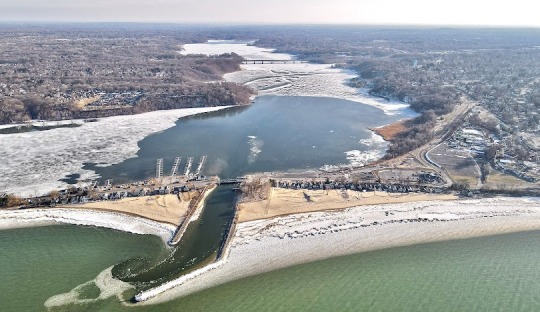
Irondequoit, New York is a town located just northeast of the city of Rochester, along the southern shore of Lake Ontario. The area that is now Irondequoit has a long and rich history dating back thousands of years.
The region was originally inhabited by the Iroquois people, specifically the Seneca nation. The name "Irondequoit" is derived from the Seneca word "Irondekwat" which means "the place where the waves are driven in to shore". The Seneca people established settlements and fishing camps along the Irondequoit Bay and Genesee River in this area.
European settlers first arrived in the late 18th century, establishing farms and small communities. Irondequoit was officially incorporated as a town in 1839, having previously been part of the town of Brighton. In the late 1800s, Irondequoit became a popular summer resort destination, with hotels, amusement parks, and beaches attracting visitors from Rochester and beyond.
The early 20th century saw significant growth and development in Irondequoit. The construction of the Erie Canal and the rise of the automobile industry led to the construction of many homes, businesses, and infrastructure in the town. Landmarks like the Irondequoit Plaza, one of the first indoor shopping malls in the United States, were established during this period.
Today, Irondequoit is a thriving suburban community, home to over 50,000 residents. It remains an important part of the Rochester metropolitan area, with a mix of residential neighborhoods, commercial districts, parks, and recreational areas. While much has changed over the centuries, Irondequoit continues to build upon its rich history and serve as an attractive place for people to live, work, and visit.

Roofing is an essential industry in Irondequoit, New York, a thriving suburb of Rochester. With a diverse mix of residential, commercial, and industrial properties, the town requires capable and reliable roofing contractor to meet the area's construction and renovation needs.
Irondequoit's climate, with cold winters and hot, humid summers, can take a toll on roofing materials. This means homeowners and business owners must be proactive in maintaining their roofs to prevent leaks, damage, and energy inefficiency. Local roofing companies in Irondequoit specialize in a variety of roofing systems, including asphalt shingles, metal roofs, flat roofs, and tile roofs, to meet the varying needs of properties in the region.
Many roofing Irondequoit contractors offer comprehensive services, from initial roof inspections and damage assessments to complete roof replacements and emergency repairs. Keeping up with the latest roofing technologies and building codes is crucial, as Irondequoit continues to evolve and new construction projects emerge.
Beyond just installations and repairs, Irondequoit roofing companies also play a role in promoting sustainable practices. They advise homeowners and businesses on energy-efficient roofing options, such as reflective and green roofs, which can help reduce energy costs and minimize environmental impact.
The roofing industry in Irondequoit not only supports the local economy through job creation and tax revenue, but also contributes to the overall quality of life in the community. Well-maintained roofs not only protect property values, but also enhance the aesthetic appeal of Irondequoit's neighborhoods and commercial districts.
As Irondequoit continues to grow and develop, the demand for skilled and reliable roofing professionals will only increase. The town's roofing industry plays a vital role in ensuring the structural integrity, energy efficiency, and visual appeal of both residential and commercial properties throughout the area.
Highview Roofing Company 4671 hall center rd Walworth,NY,14568 (585) 440-7663 https://highviewroofingny.com/
youtube
0 notes
Text
1 Week in Tasmania
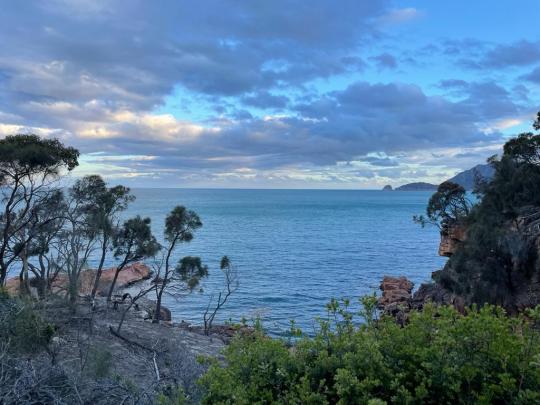
View from Freycinet Lodge in Freycinet National Park
Overview
My candid tl;dr: Tasmania is pretty, but not as stunning as nearby New Zealand. Given what a long trip it is from the U.S., I’d only prioritize traveling this far again for New Zealand.
Tasmania is an Australian island off the southeast coast of the continent. I visited with my parents in November, which is springtime – shoulder season so not crowded, but still a bit cold and windy.
The highlight for me was that every local person we interacted with was so incredibly nice. There was also some neat wildlife that I haven’t seen anywhere else – wallabies, paddy melons, wombats, kangaroos. And bathrooms everywhere were so clean – I’m talking Japan levels of clean!
We did a 1-week road trip starting in the capital city, Hobart, and driving out to two national parks: Freycinet National Park and Cradle Mountain National Park. We ended in the scenic town of Launceston. Each one of these spots had its own charm -- my favorite was Cradle Mountain because it was so pretty and full of wildlife. More on each spot below.
Disclaimer: This blog post is light on discussion of logistics because I did not plan this trip – I just tagged along with my parents.
Hobart
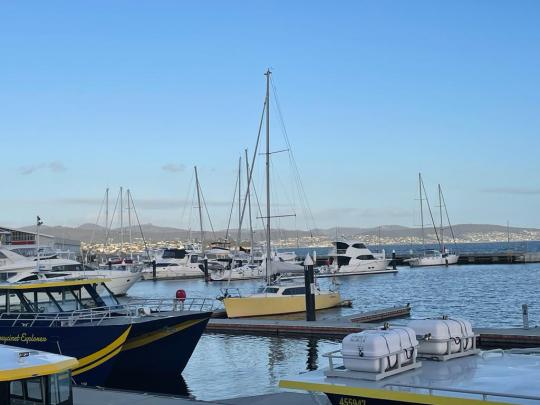
Hobart Harbor
Hobart is the capital city of Tasmania. It’s a ~2 hour flight from Sydney, and it’s also possible to fly there or take a ferry from Melbourne.
I spent 3 nights / 2 days in Hobart and did 2 day trips – one to Bruny Island for some brief, scenic walks (a ~2 hour drive each way, including a ferry) and the other to Port Arthur to tour an old penitentiary site and eat treats at a lavender farm along the way (a ~90 min drive each way, no ferry). Both were fine, but not exactly what I look for on travels (too much driving and touristy stuff vs. longer, scenic hikes), so I’d skip them if I went back.
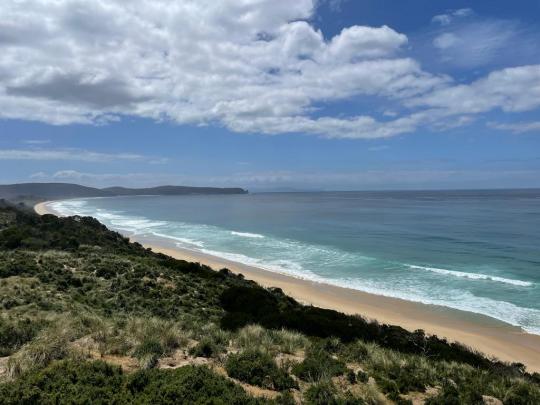
Bruny Island coastline
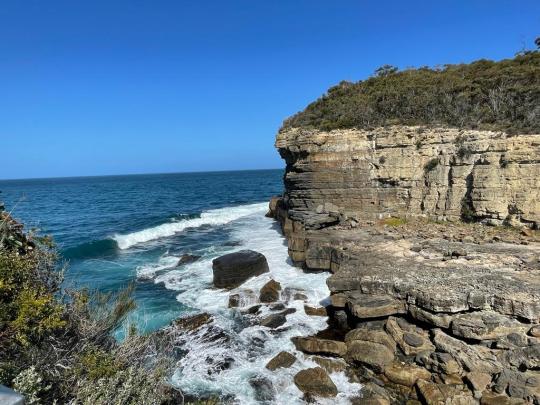
Eagleneck coastline area near Port Arthur
If I were to organize one perfect day in Hobart, it would look like this:
Stay at the Macq01 hotel along the harbor – it was a super cute and well appointed boutique hotel with wonderful staff and a convenient location. One of the best hotels I’ve stayed at in recent memory
Sail on the harbor – we didn’t do this, but it looked picturesque and we saw signs for sailing excursions right outside the Macq01 hotel
Walk (~25 mins) or drive to the botanical gardens – these were some of the nicest gardens I’ve ever seen and entry is free
Eat Thai food at Bite Me (~10 min drive from the hotel, plenty of vegetarian options)
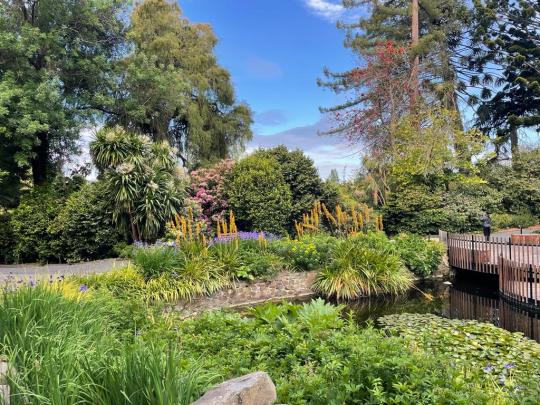
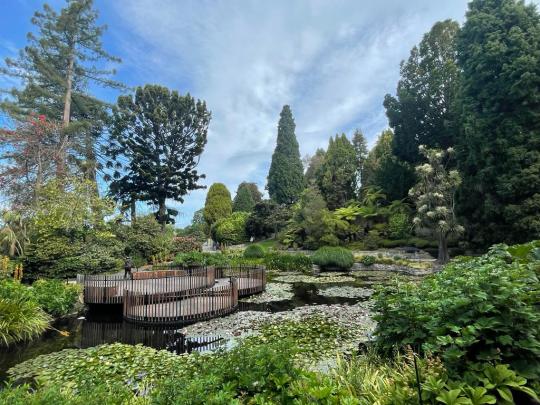
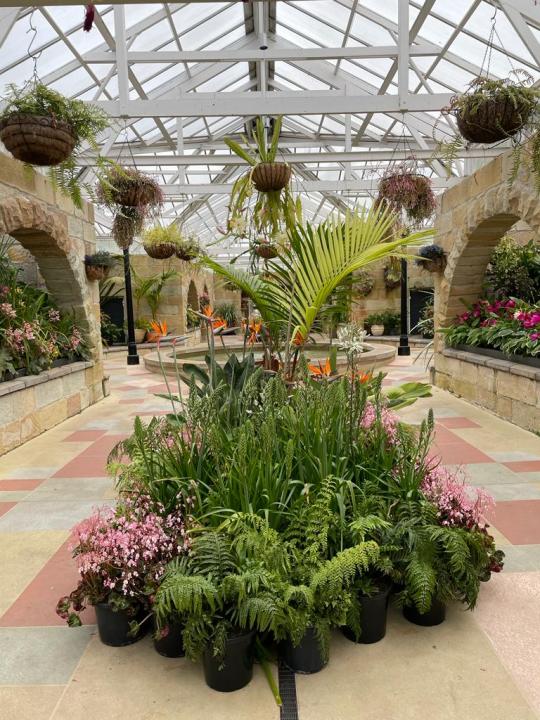
Hobart's botanical gardens stole my heart
Freycinet National Park
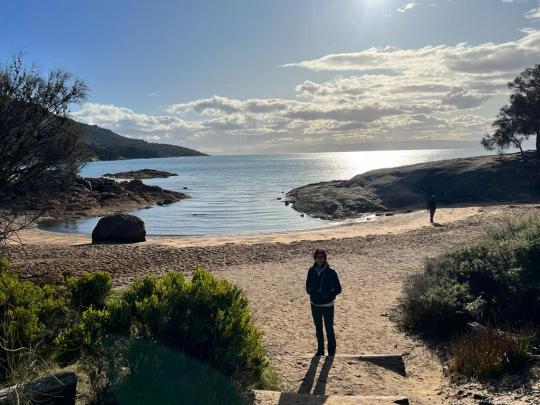
On the beach near Freycinet Lodge
This national park is a ~3 hour drive northeast from Hobart. It’s nice and reminded me of parts of the California coastline like Mendocino, Bodega Bay, Carmel, or Monterey, but it doesn’t compare to some of the most scenic places we’ve visited (e.g., New Zealand, Norway, Switzerland, our favorite parks in the U.S.). I’d go if I were nearby and for some reason couldn’t easily make it to New Zealand. So if you find yourself in the area, here are my recommendations:
Stay at Freycinet Lodge – We got a cabin and it was very comfortable, if not fancy like Macq01. The highlights are the location on the water and the food, which was excellent. And of course, like everywhere we visited, the staff were super nice.
Kayak with Freycinet Paddle – We enjoyed our 3 hour kayaking expedition and thought the guides were very nice and helpful. We got super lucky to have nice weather with a sunny day – the guides mentioned that just the day before it was very windy and cold, and people couldn’t feel their hands. It’s probably a safer bet weather-wise to do this a bit later in the season. We got lucky and saw dolphins!
Walk at Cape Tourville – This ~15 min, mostly flat walk was a ~10 min drive from our hotel and had stunning views of the ocean.
Walk to the Wineglass Bay Lookout – This ~90 min walk was a few minutes’ drive from our hotel and also had very nice ocean views. It’s definitely not hard, but there are some steps and there is no shade, so it’s nicer to do it in the morning or evening to avoid the harsh sun.
There may be some other, longer hikes as well – I’d have loved to explore more had the group been up for it.

Kayaking at Freycinet National Park

Wineglass Bay Lookout
Cradle Mountain National Park

We saw loads of wallabies on the side of the road at Cradle Mountain National Park (and a few at Freycinet, too)
We drove ~4 hours from Freycinet National Park to Cradle Mountain. Since Cradle Mountain isn’t exactly known for its food, we stopped along the week to pick up sandwich materials. The drive felt a bit tedious and the road is very windy towards the end, but once we finally arrived I really enjoyed the scenery and the following walks:
Dove Lake Circuit – This is a ~7 km, mostly flat walk around Dove Lake inside the national park. The vegetation around the water is quite unique and pretty. It reminded me a bit of the Jenny Lake walk at Grand Teton National Park, except the Dove Lake loop was much shorter.
Logistical note: You can park at the Visitor Center, buy a 72-hour shuttle ticket for AUD $15 pp, and take the shuttle ~20 mins to the last stop (Dove Lake) to start this walk. Shuttles were running every 10-15 minutes when we were there, and as it wasn’t super crowded we didn’t have any difficulty getting on a shuttle.
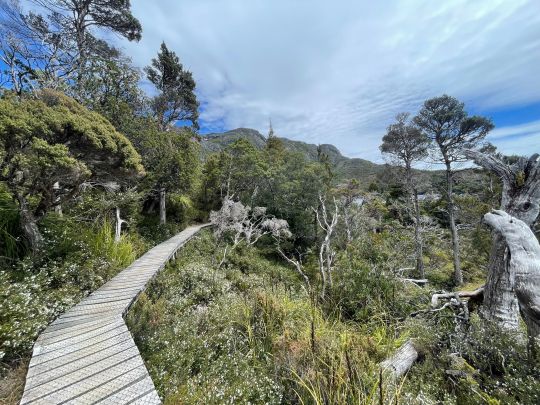
Dove Lake circuit -- most of the walk is on a well-maintained boardwalk
Enchanted Walk – This is a ~20 min roundtrip walk that is super pretty, mossy, and otherworldly. It reminded me of a walk we did at Olympic National Park.
Logistical note: You don’t have to take the park shuttle to access this one (though you can if you want). You can drive your car past the park visitor center and park at the ranger station to start the walk.
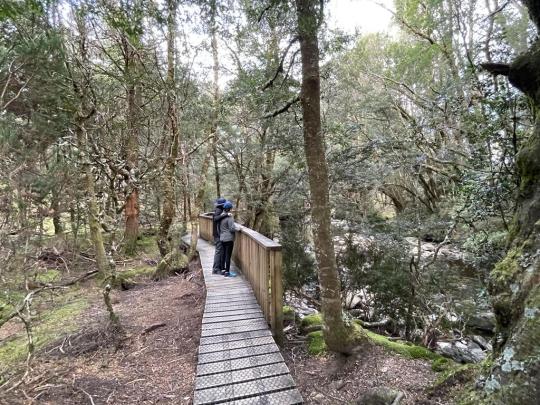
This photo definitely doesn't do justice to the Enchanted Walk
King Billy Trail – This is a ~40 min walk that starts right by the Enchanted Walk. We only walked ~10 mins of it in the evening, but we saw a kangaroo and a wallaby in just that short time. It seemed like a really nice trail as well.
The park has many more trails which I didn’t get a chance to explore, but which seemed really nice.
Eat at the dining room at Peppers Lodge. Vegetarian food options did not seem strong in the Cradle Mountain Area, but I was appreciative of the salad options at Peppers. Looking out the window from the dining room, we saw quite a few wallabies running around at night!

Outside Peppers Lodge
We stayed at the Cradle Mountain Hotel, which was a bit sad – more expensive and less nice than anywhere else we stayed in Tasmania. This reminded me a bit of the U.S., where the level of niceness of National Park lodges often seems inversely proportional to the surrounding scenery. It’s not clear to me that there are nicer housing options in the area, and the hotel was okay, but it’s worth checking if you visit.
Launceston
I didn’t have much time in Launceston, but we did a ~2 hour stop at the Cataract Gorge Reserve which was quite nice. There were some walking trails, a lake, a café and benches for picnicking, a playground for children, and peacocks, wallabies, and birds. Parking was AUD $6.
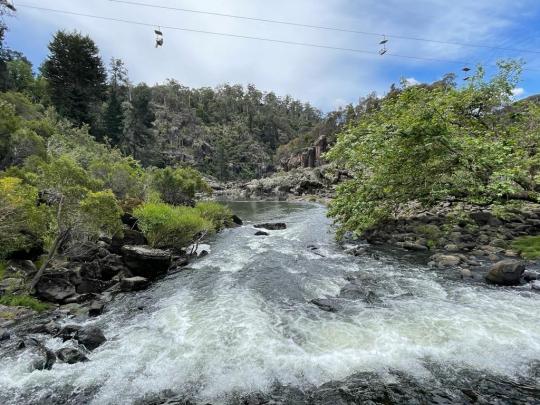
Cataract Gorge -- the chair lift is also an option to see it aerially

Peacock at Cataract Gorge
My parents spent a night at the Mantra Charles Hotel in Launceston, which I stopped by for a bit before my flight to Sydney. The room was about as small as a standard NYC hotel room and looked a bit dated, but it seemed fine. I’m not sure what more there is to do in Launceston, other than being a convenient spot to end a Tasmania road trip.
1 note
·
View note
Text
Odisha
Odisha, formerly known as Orissa, is a state located in the eastern part of India. It is bordered by West Bengal to the northeast, Jharkhand to the north, Chhattisgarh to the west and northwest, Andhra Pradesh to the south, and the Bay of Bengal to the east.
🏛️ Odisha has a rich historical and cultural heritage. It was home to one of the earliest known civilizations in India, the Indus Valley Civilization. The state has been ruled by various dynasties and empires, including the Mauryas, Guptas, Kalingas, and Gajapatis.
⛩️ The state is renowned for its temples and architectural marvels. The Jagannath Temple in Puri, dedicated to Lord Jagannath, is one of the Char Dham pilgrimage sites for Hindus. The Sun Temple in Konark, a UNESCO World Heritage Site, is famous for its stunning architecture and intricate stone carvings.
🏞️ Odisha boasts diverse geographical features, including a long coastline of approximately 480 kilometers along the Bay of Bengal. It is known for its beautiful beaches like Puri, Chandipur, and Gopalpur, attracting tourists from around the world.
🏝️ The state is also home to several national parks and wildlife sanctuaries, such as Bhitarkanika National Park, Simlipal National Park, and Chilika Lake, the largest saltwater lake in Asia. These areas are known for their rich biodiversity and provide habitats for various species of animals and birds.
🌾 Agriculture plays a significant role in Odisha's economy, with the majority of the population engaged in farming. The state is known for its rice cultivation and produces a variety of other crops, including pulses, oilseeds, jute, and sugarcane.
🎭 Odisha has a vibrant cultural scene, with a strong emphasis on art, dance, and music. The classical dance form, Odissi, originated in the state and is widely practiced and appreciated. The Ratha Yatra festival in Puri, where the deities are taken on a grand procession, attracts millions of devotees and tourists every year.
1 note
·
View note